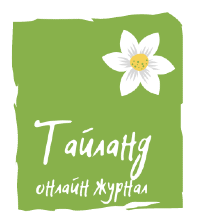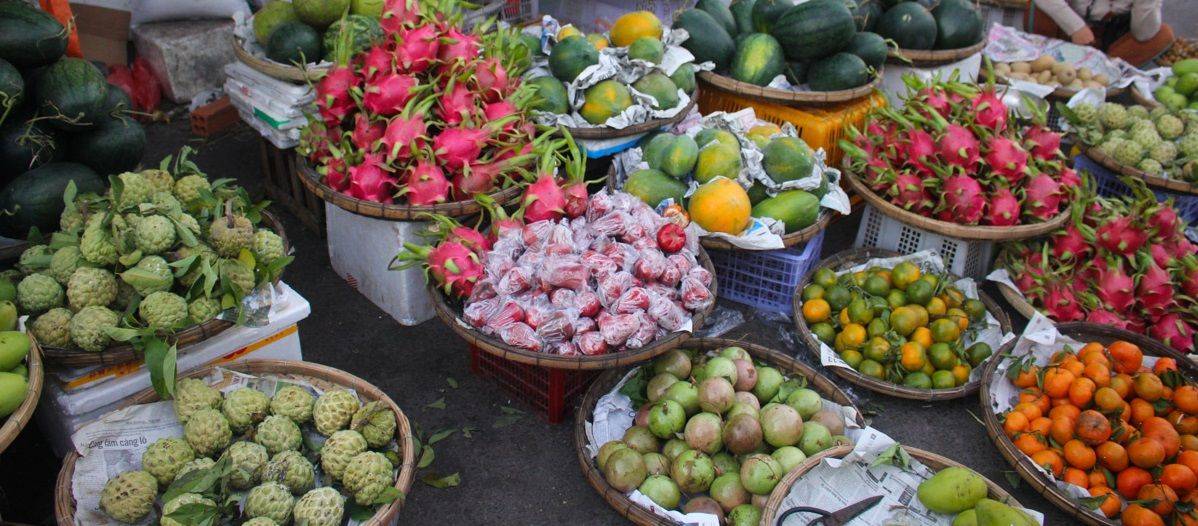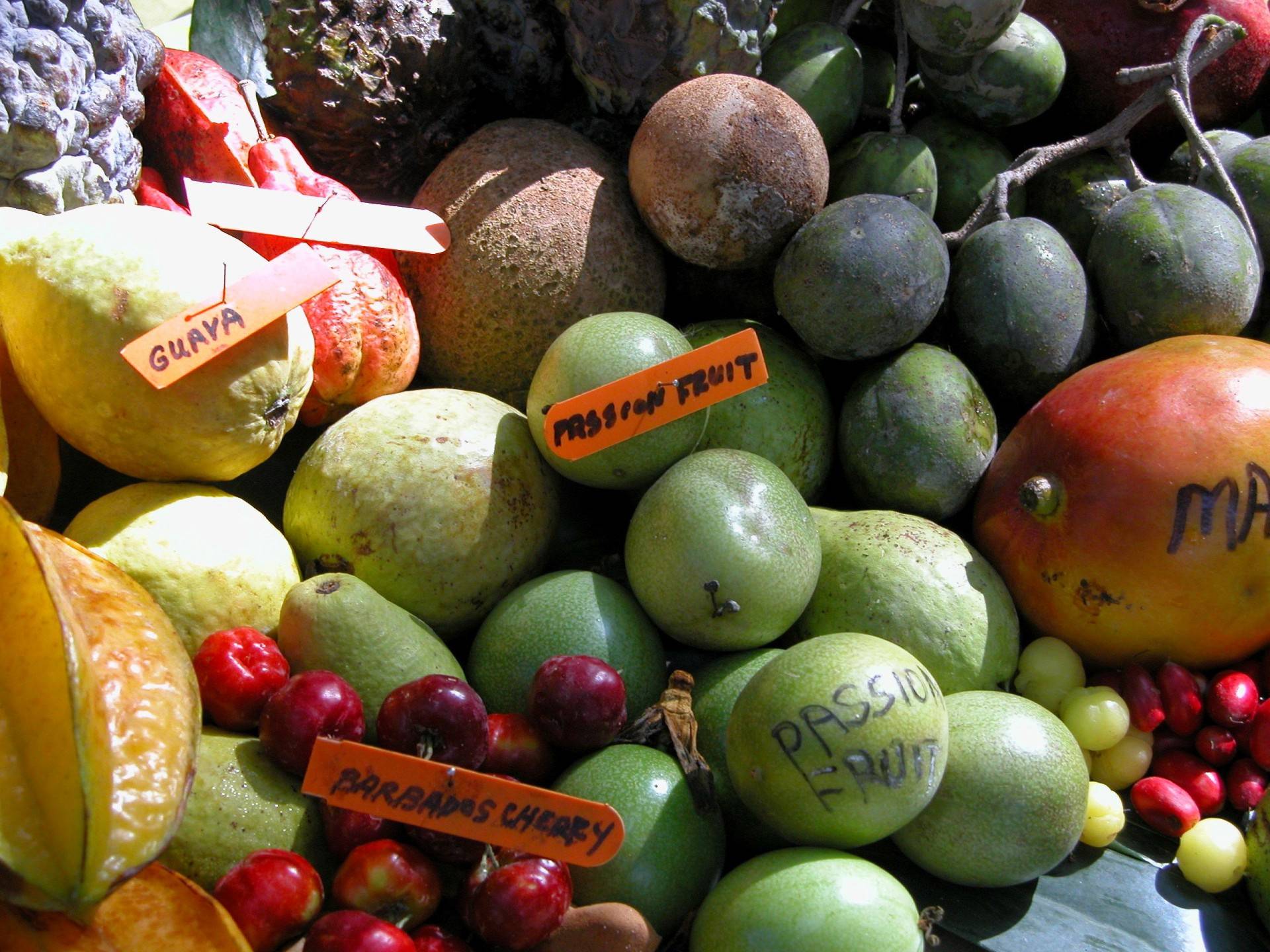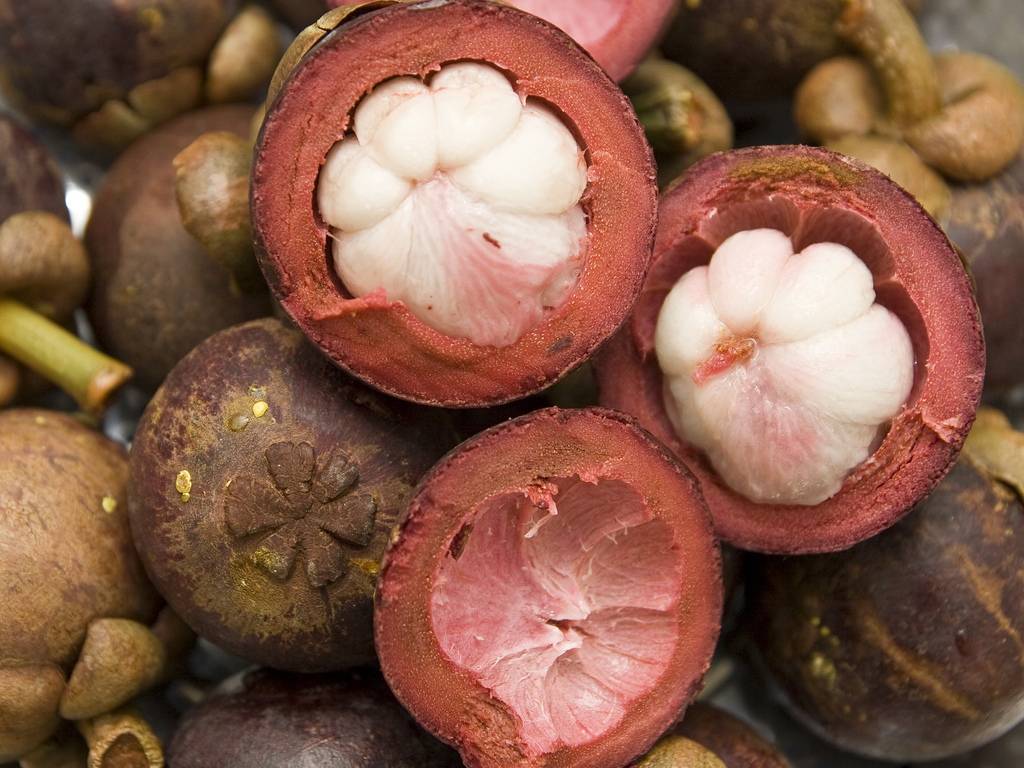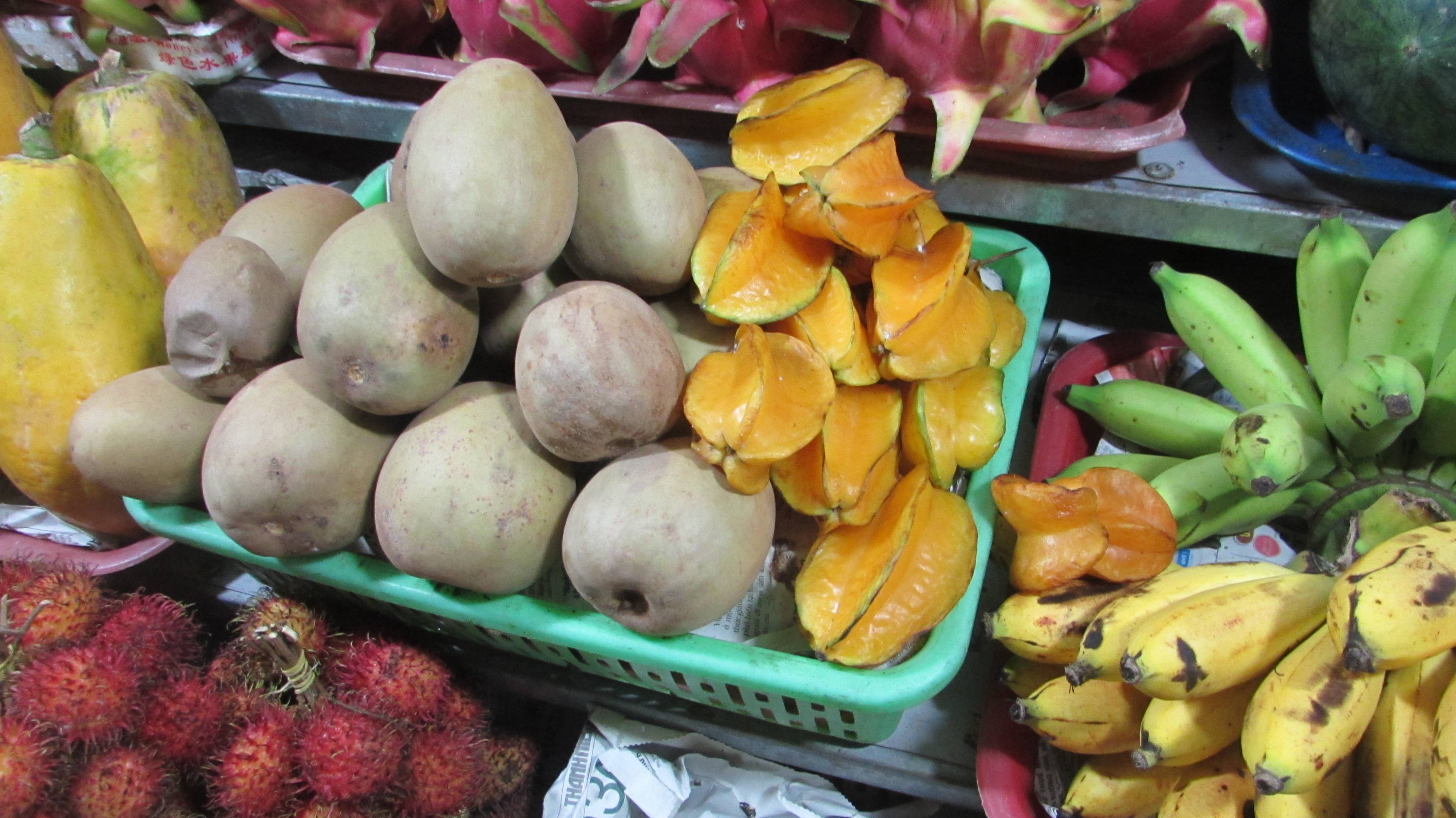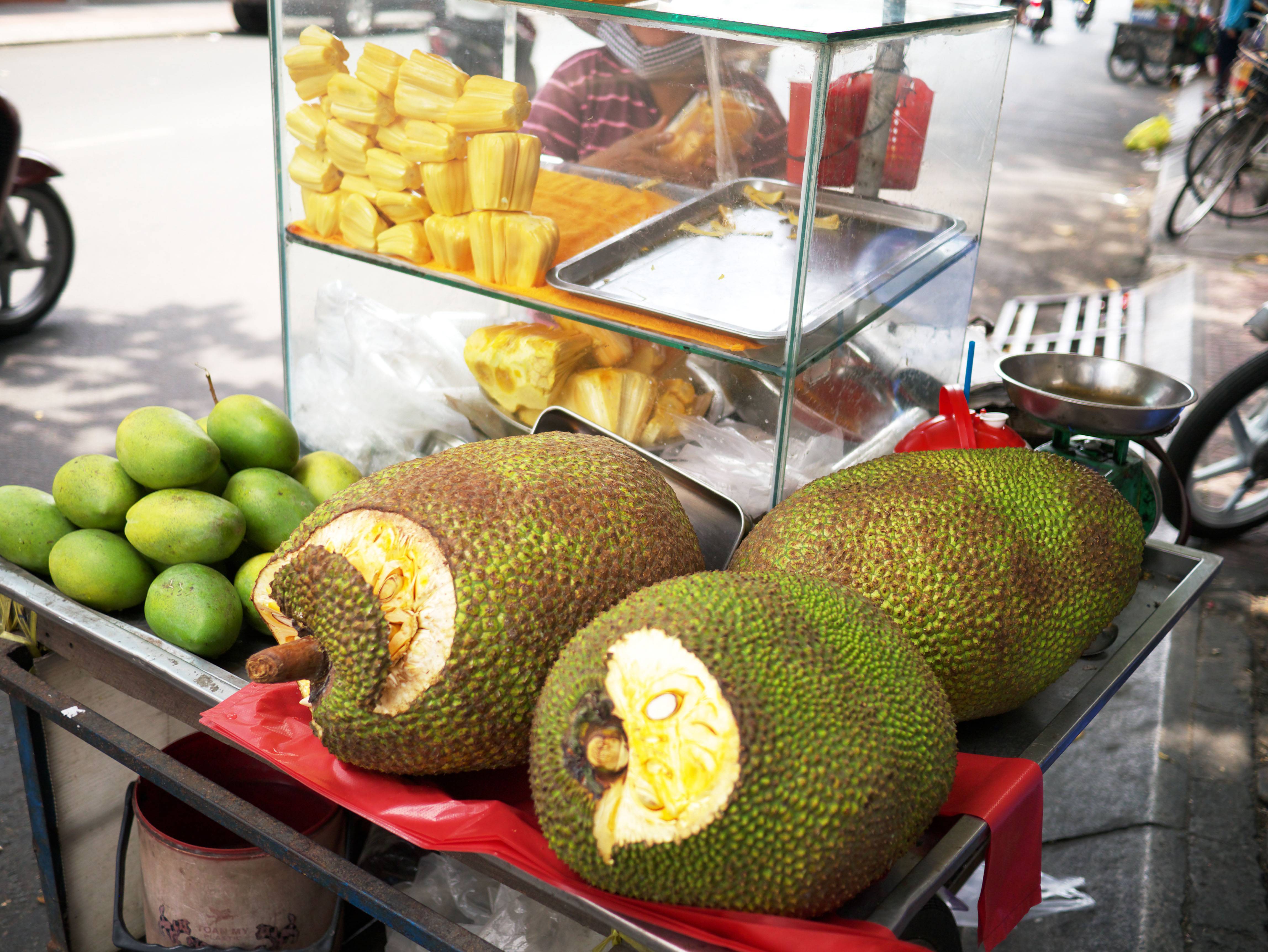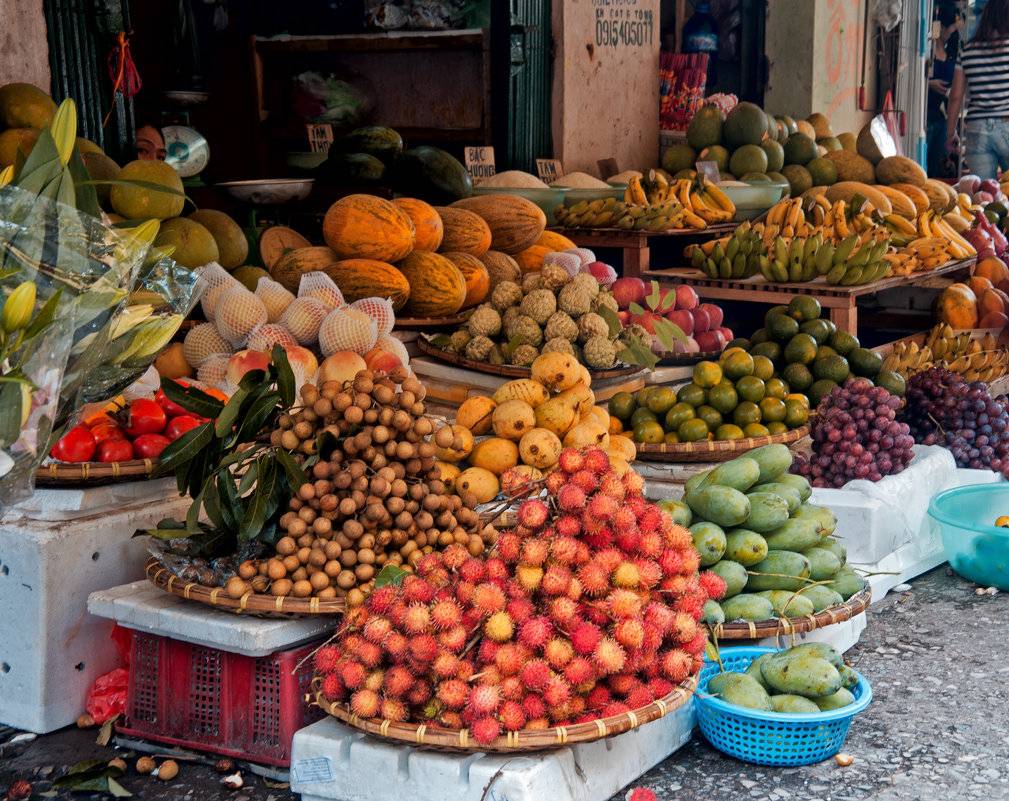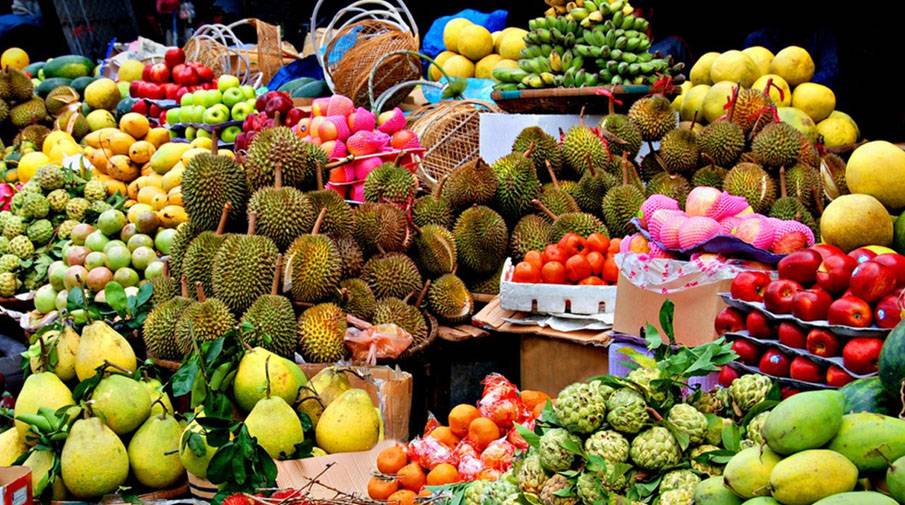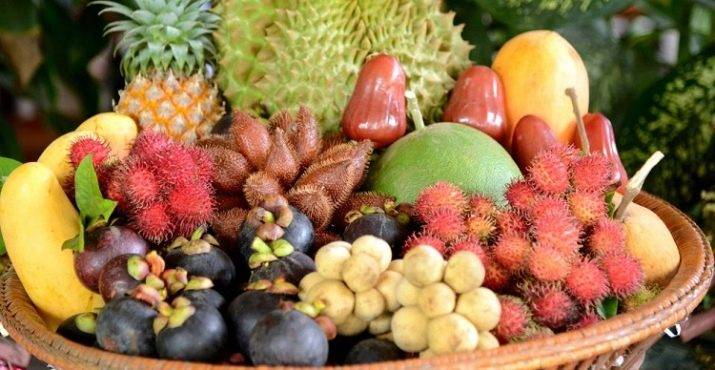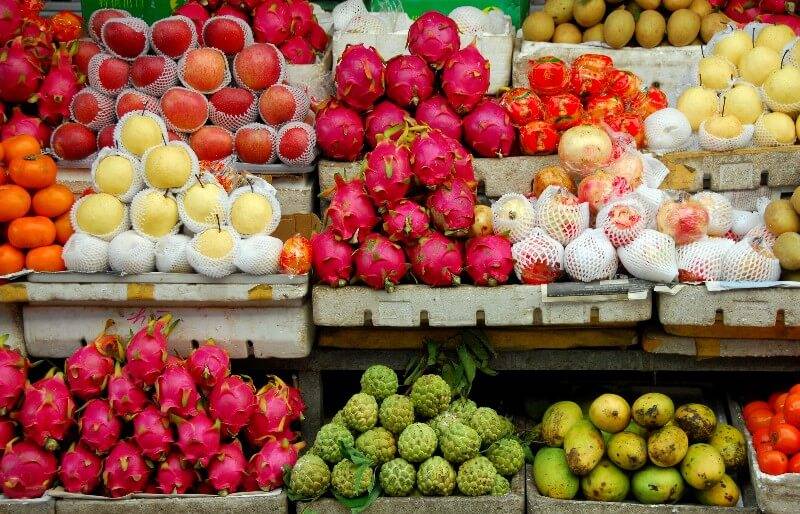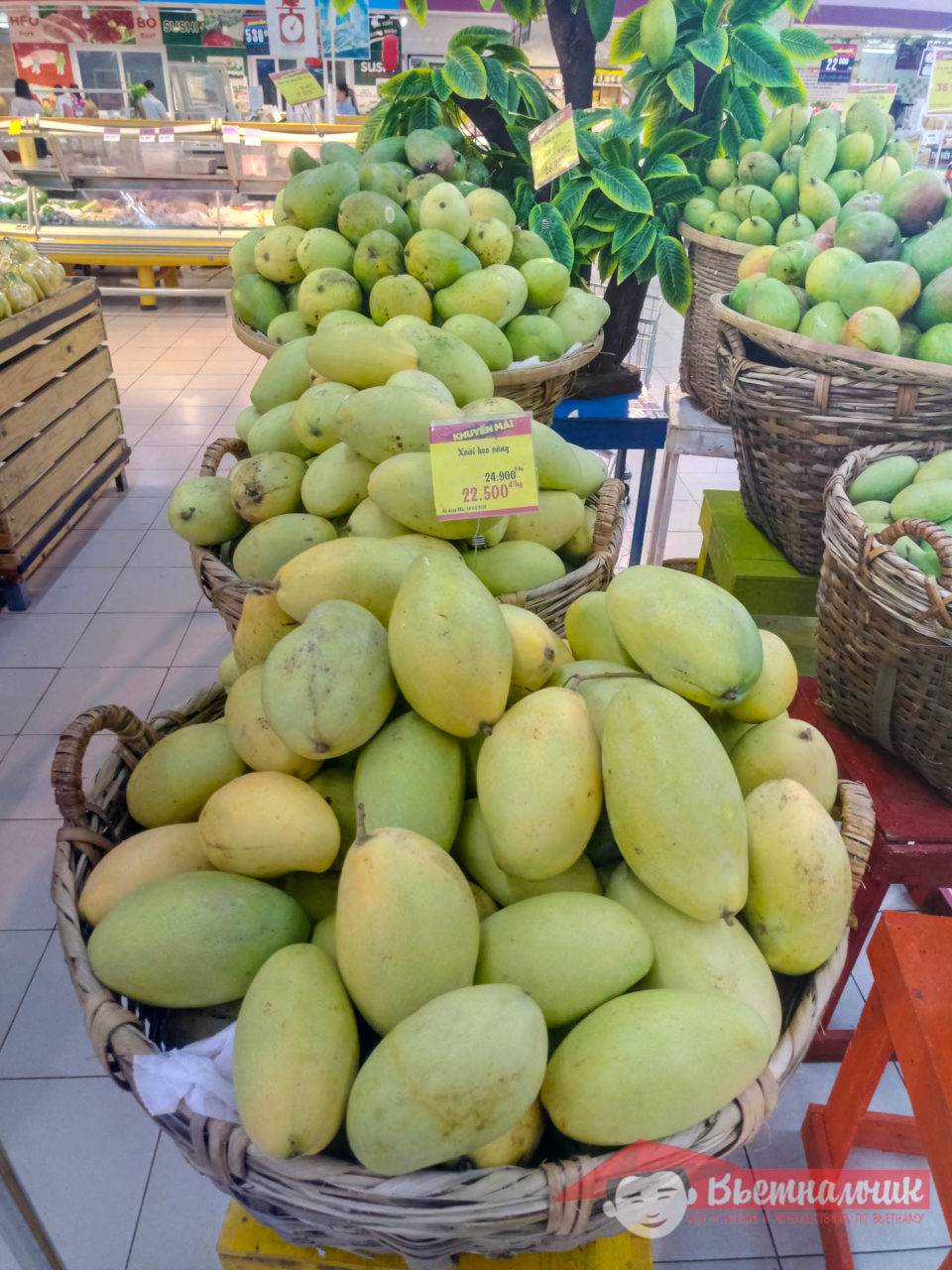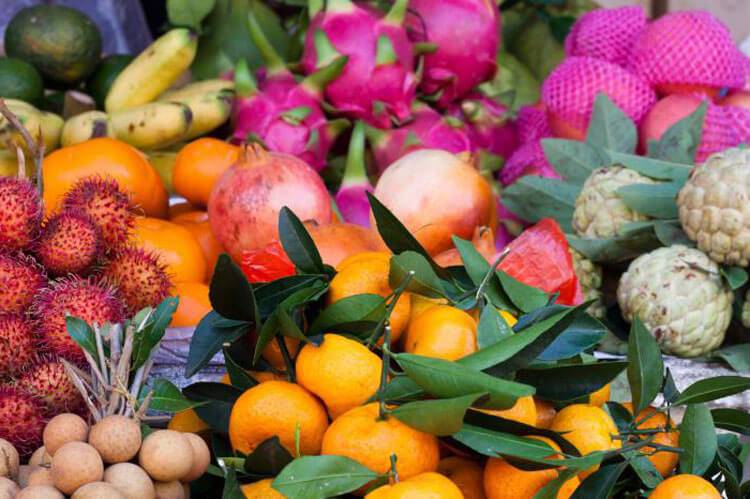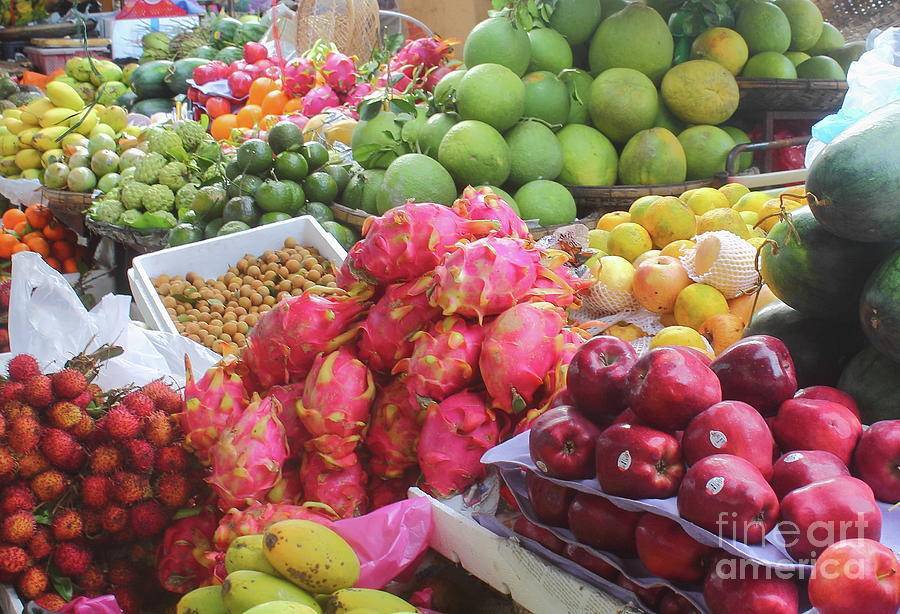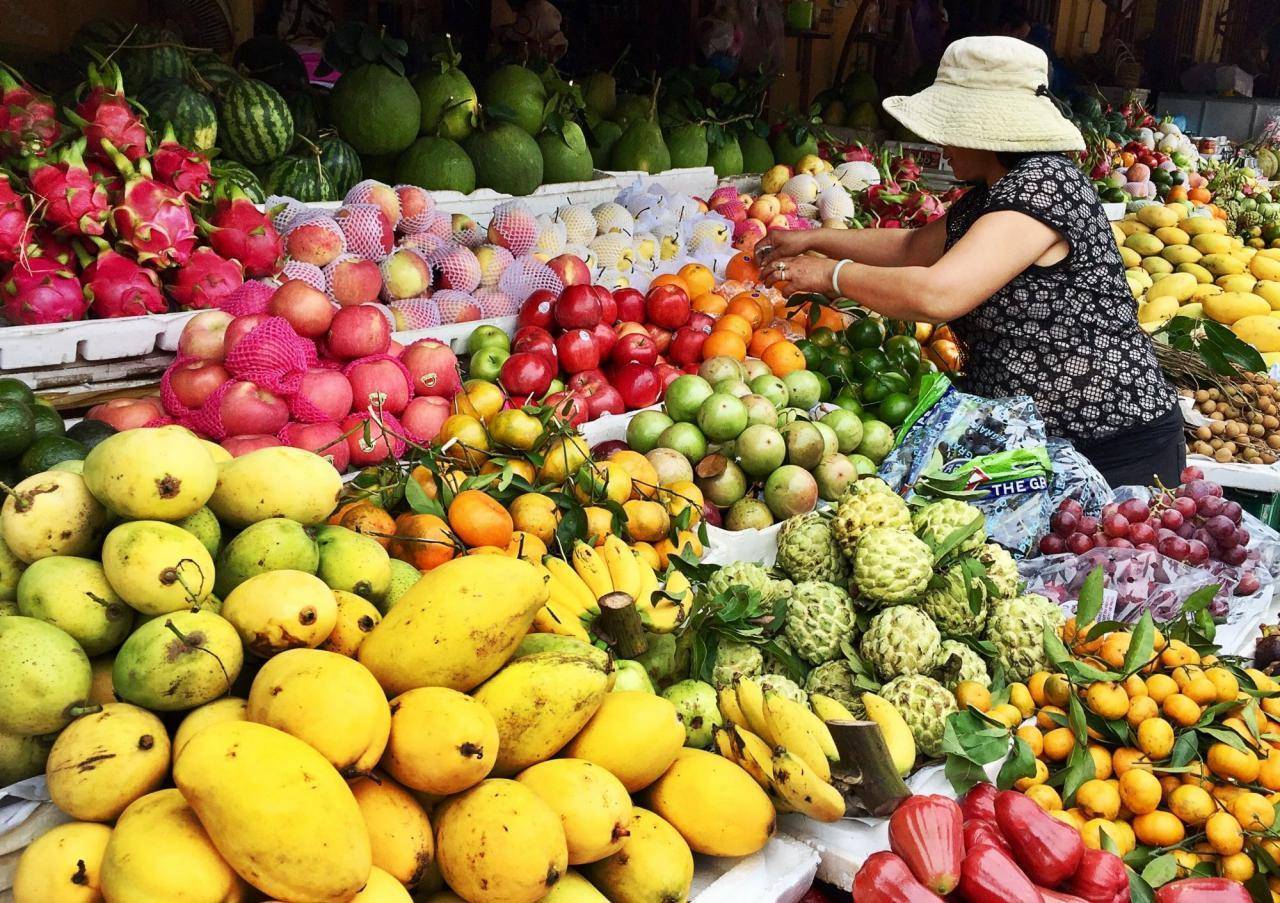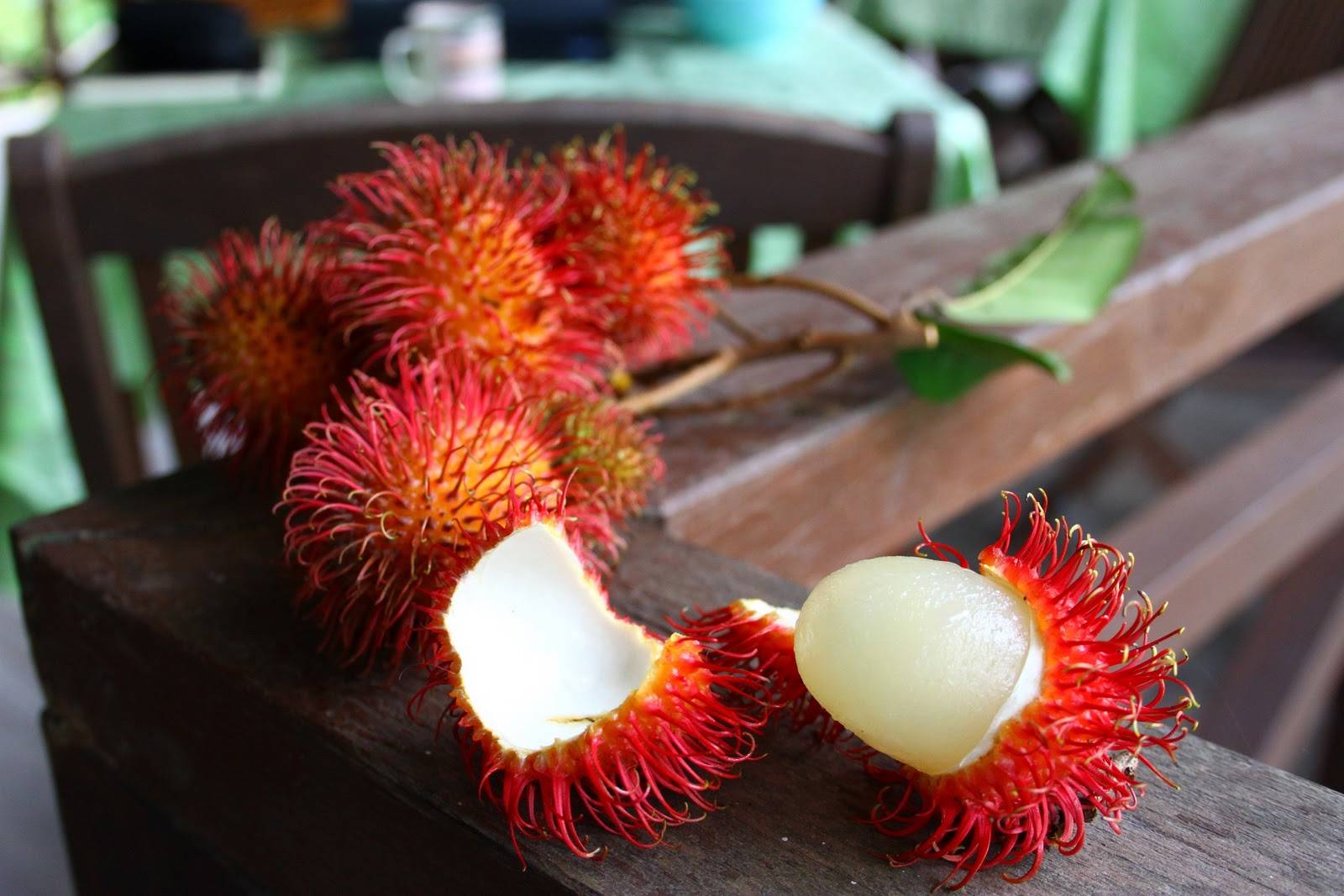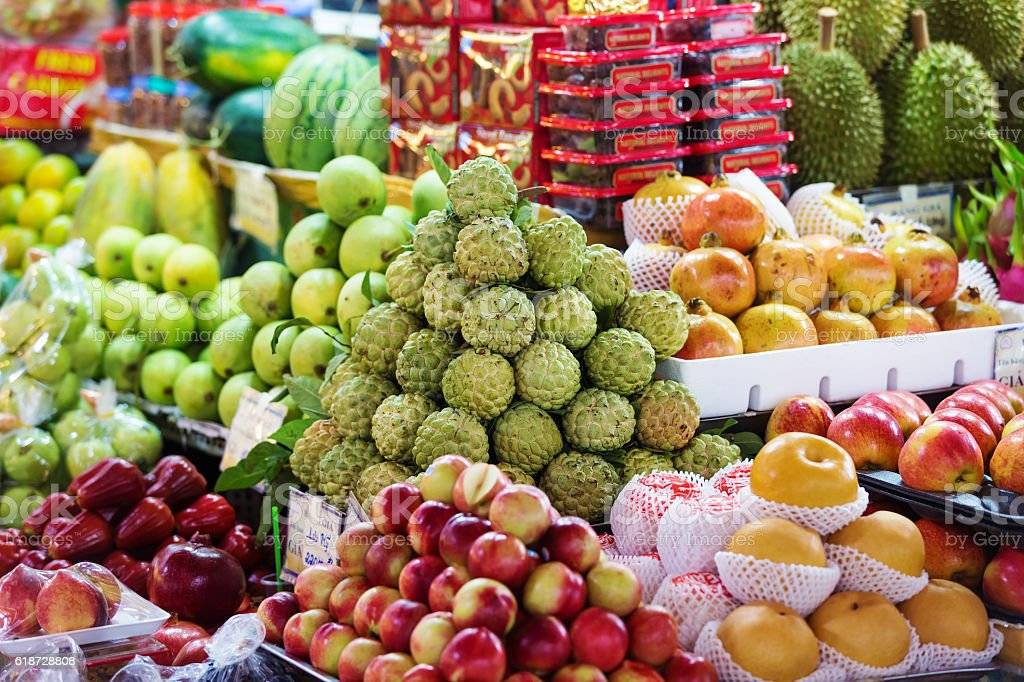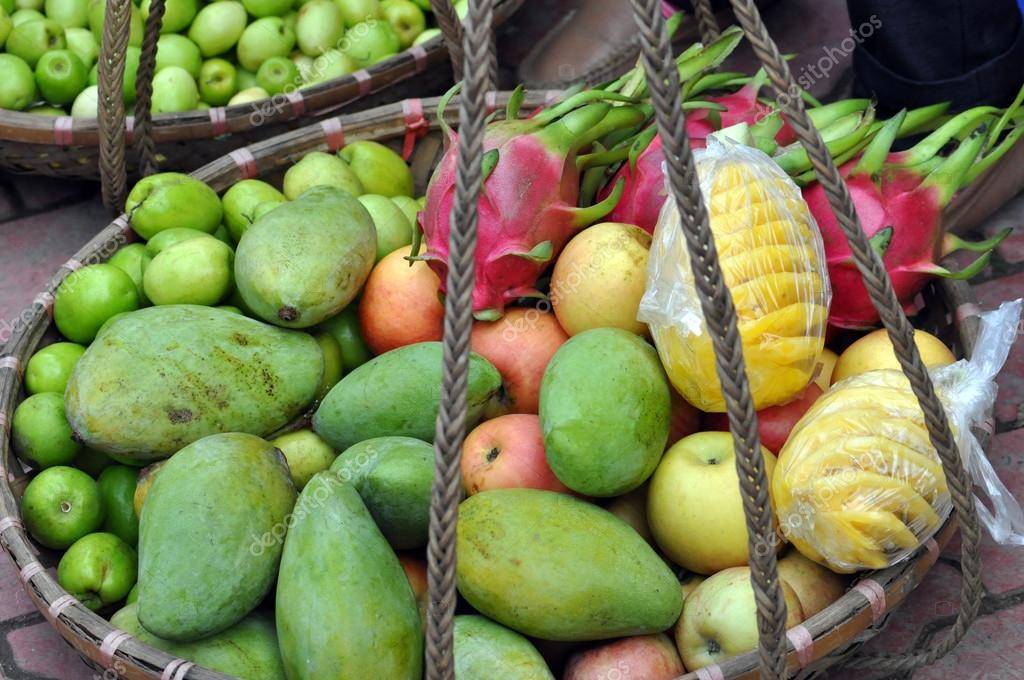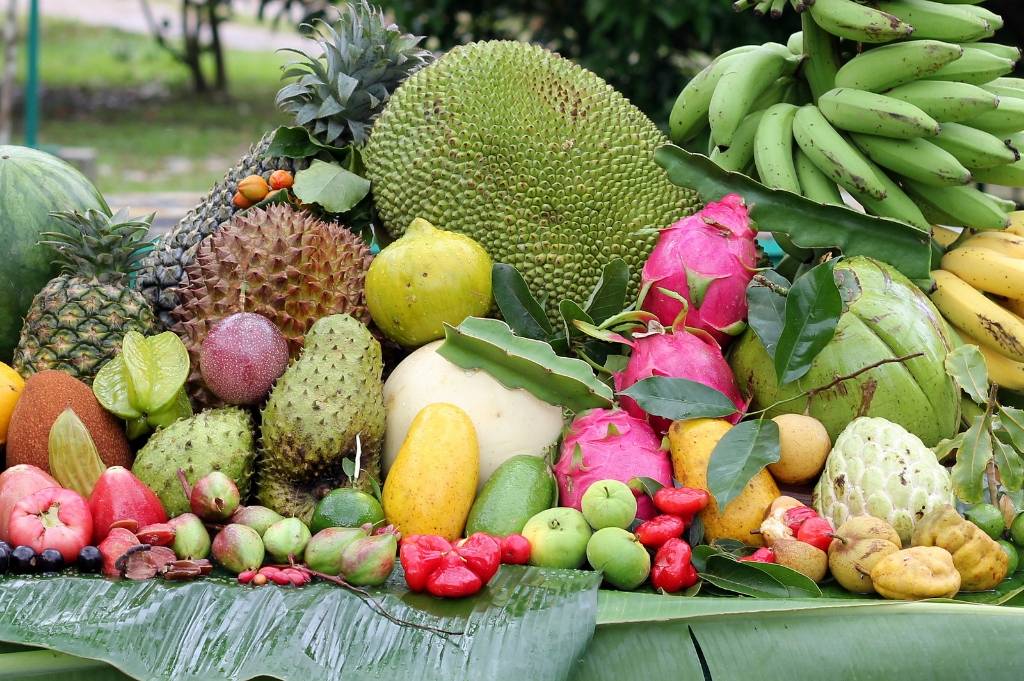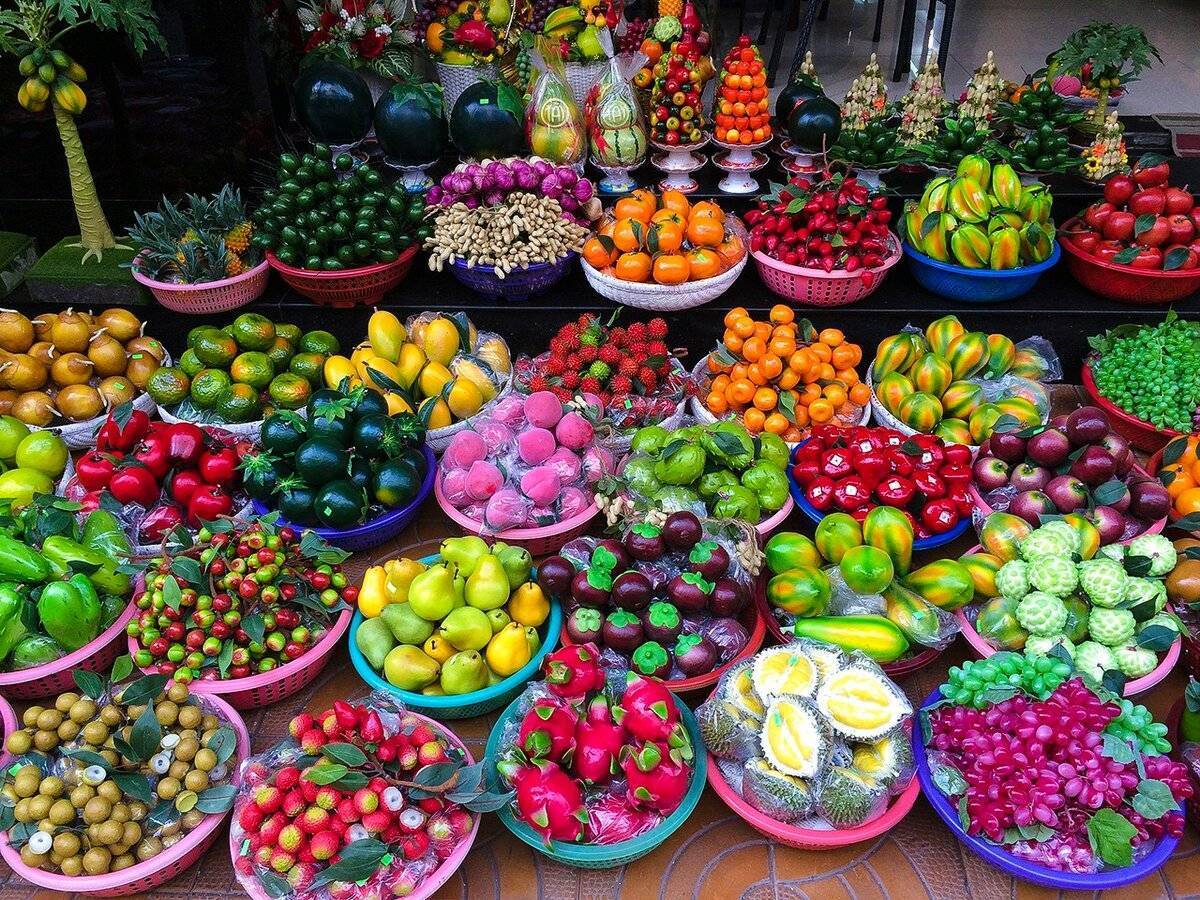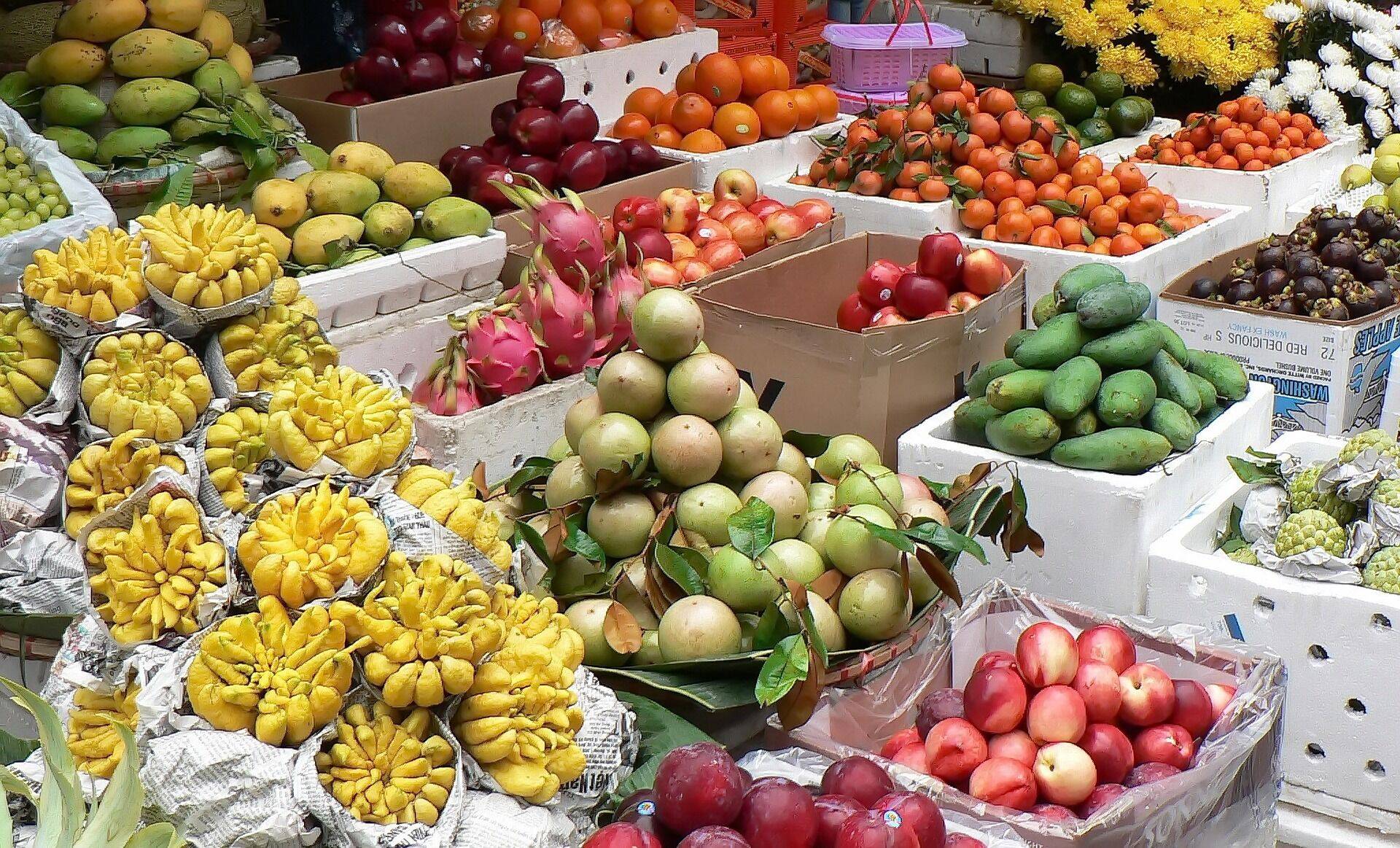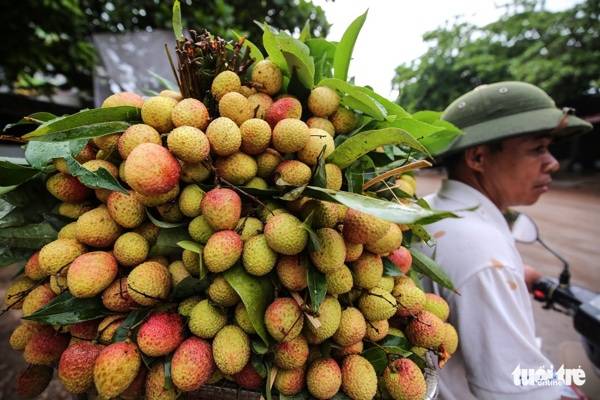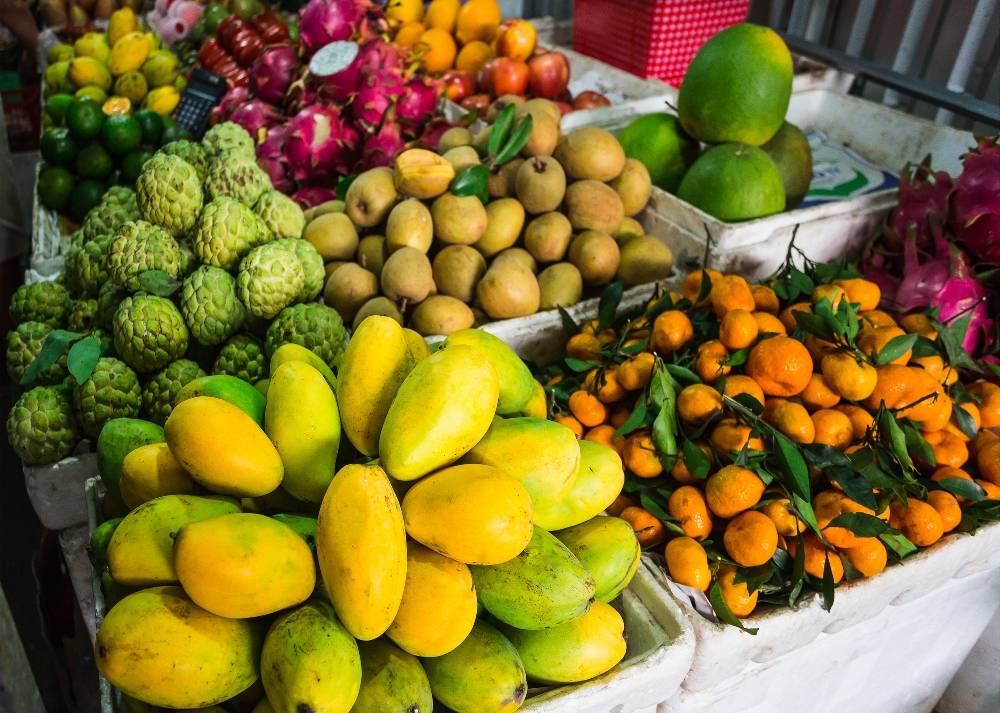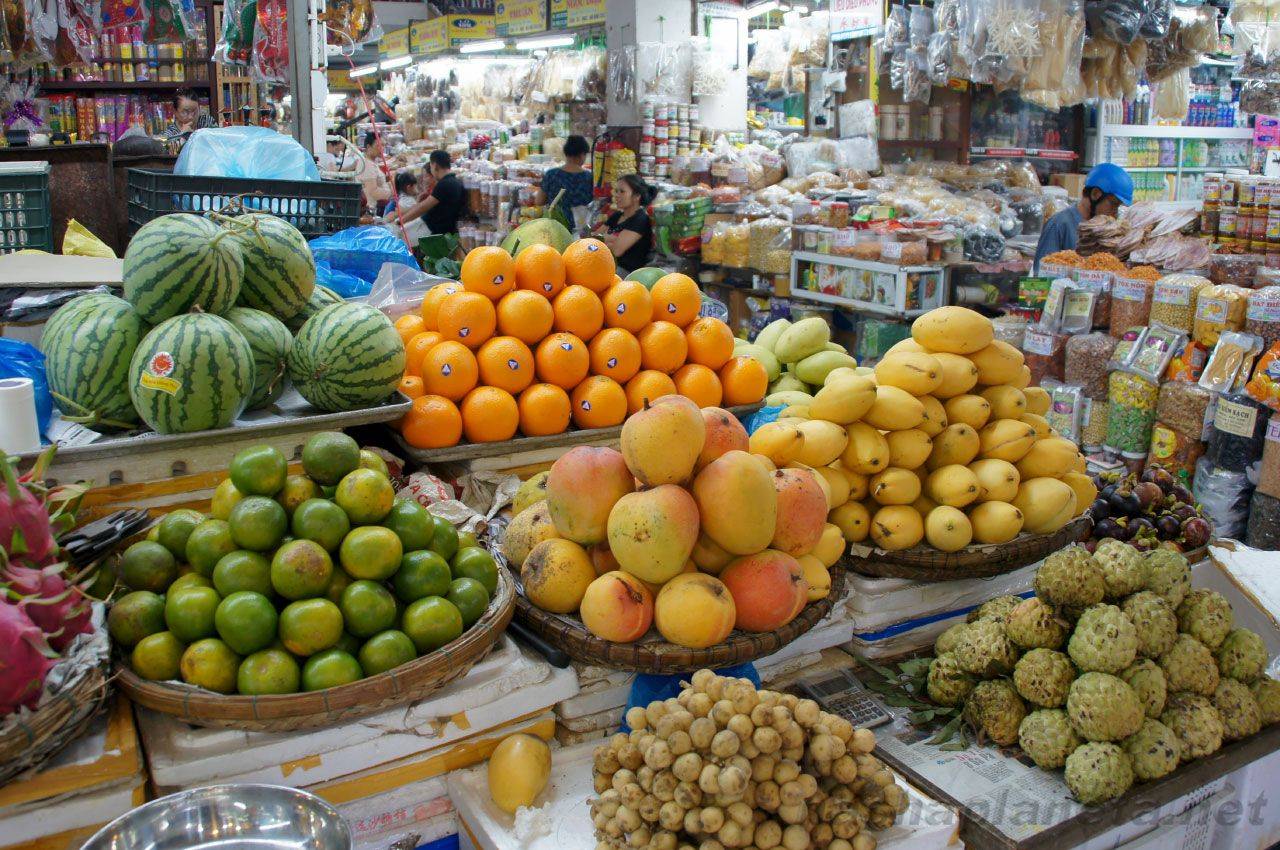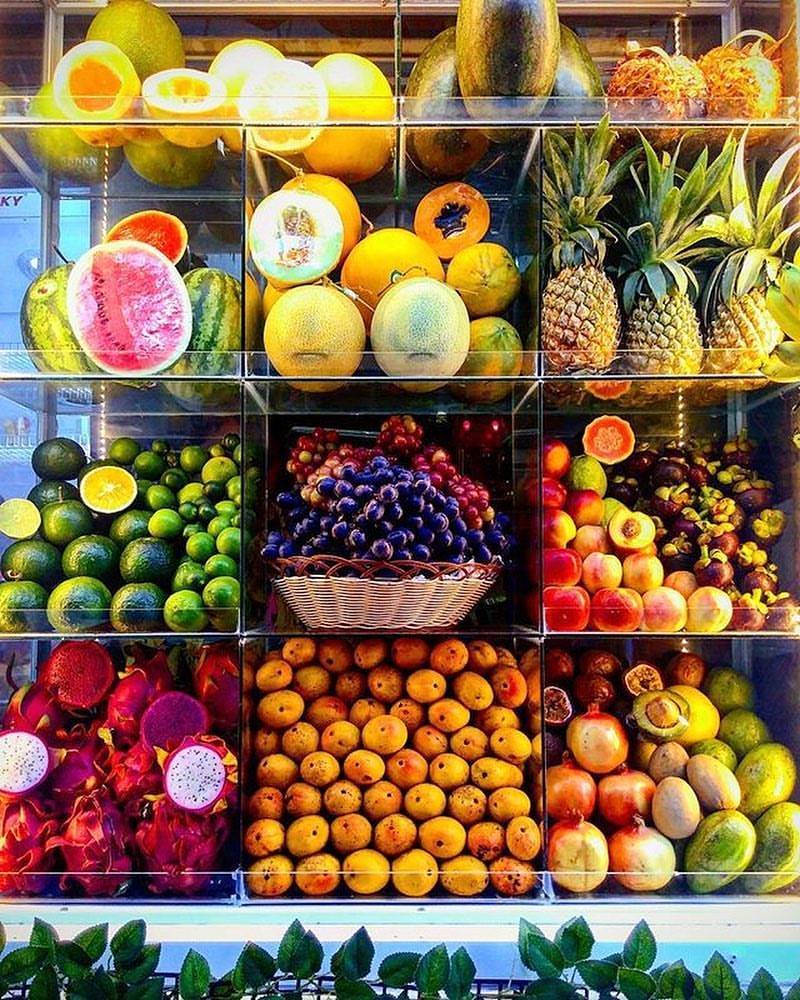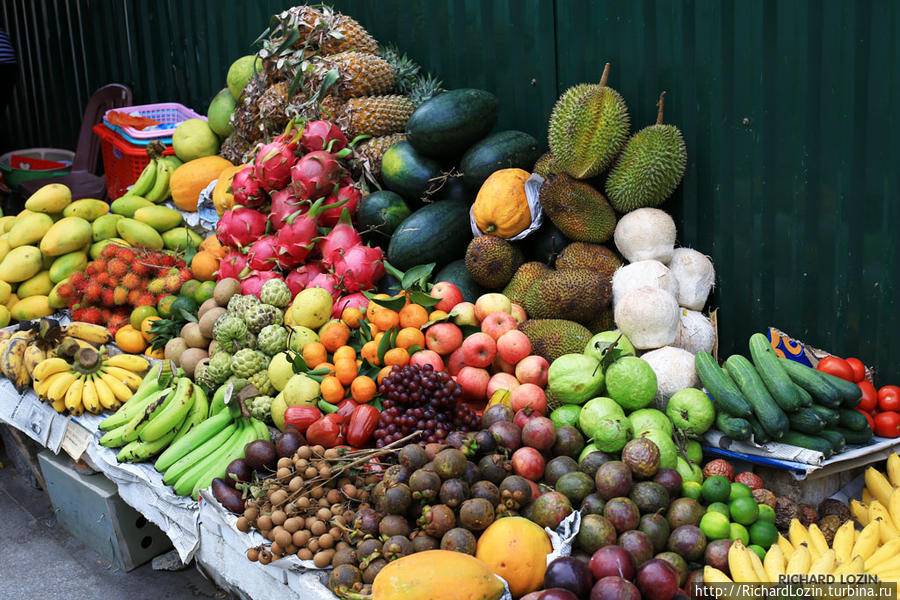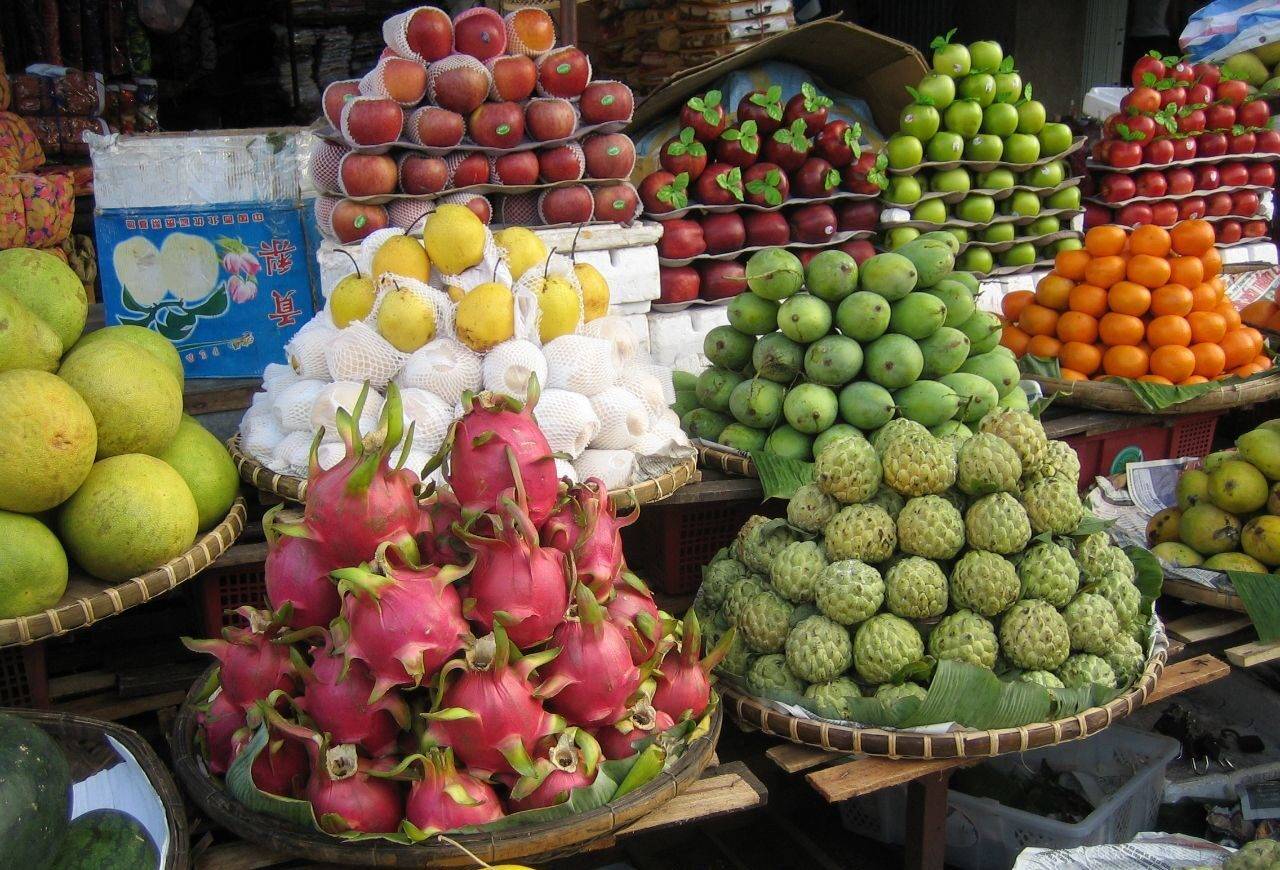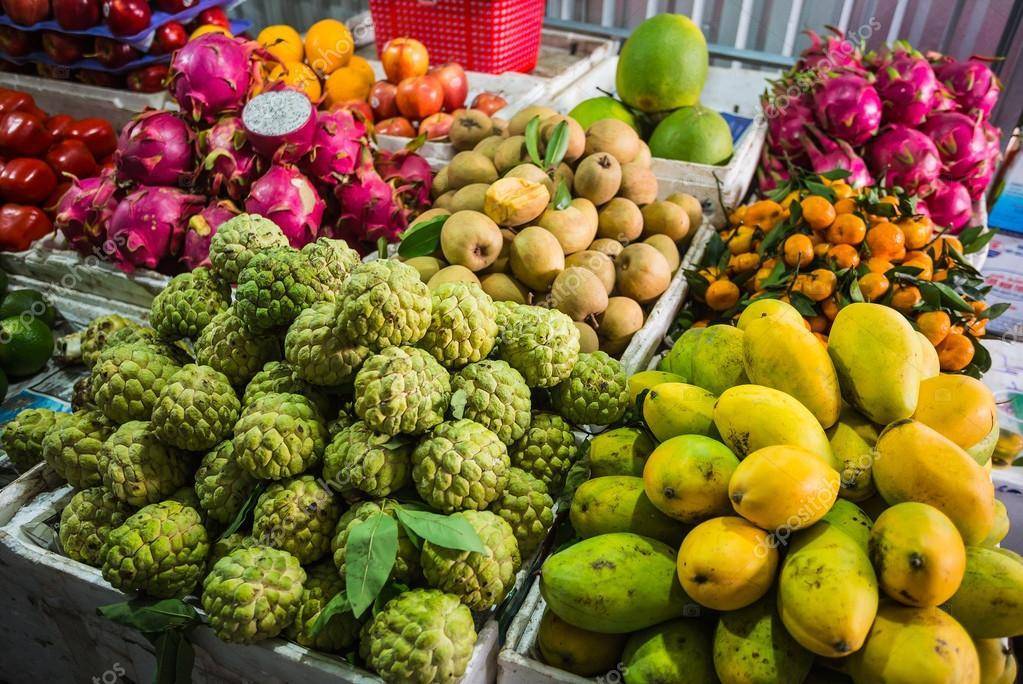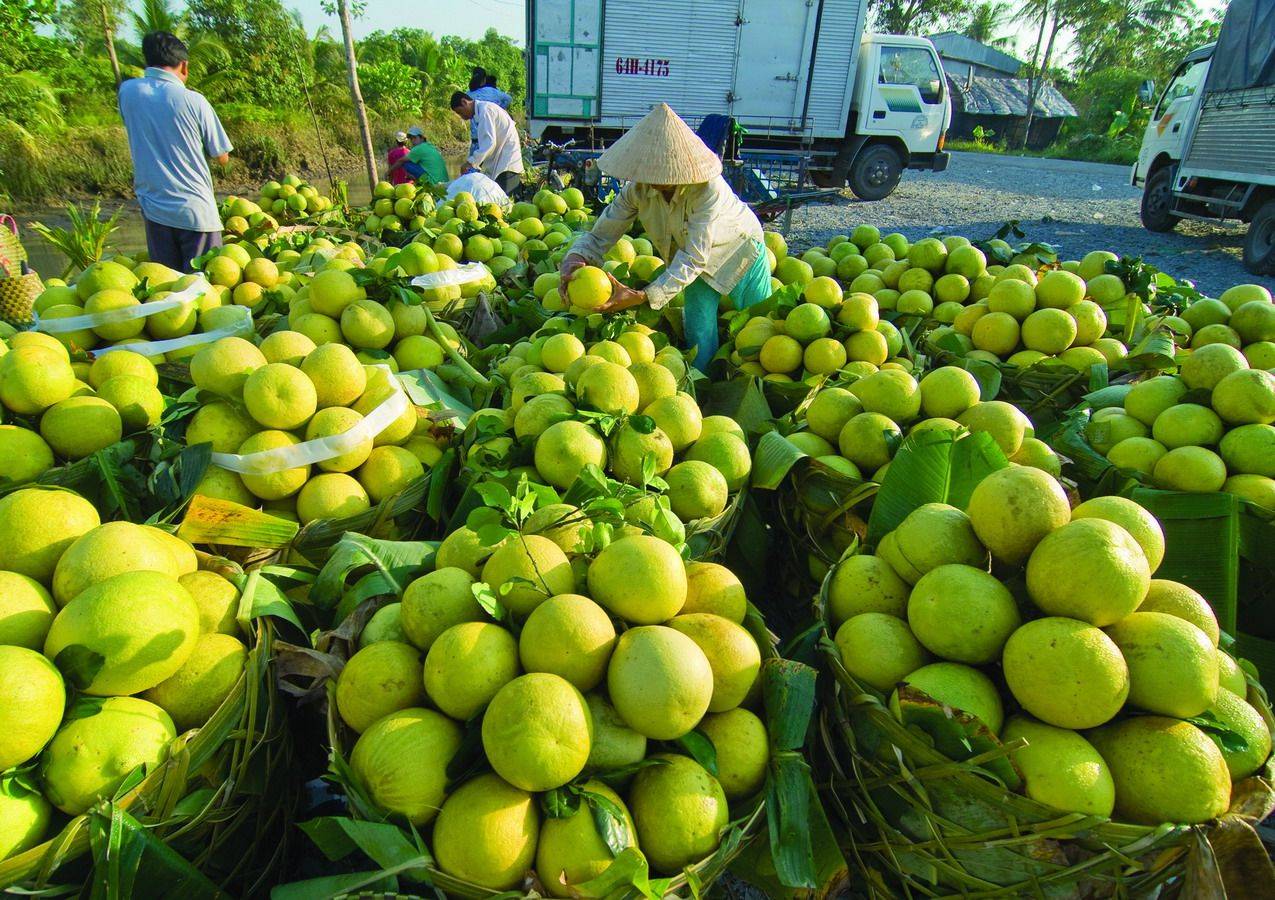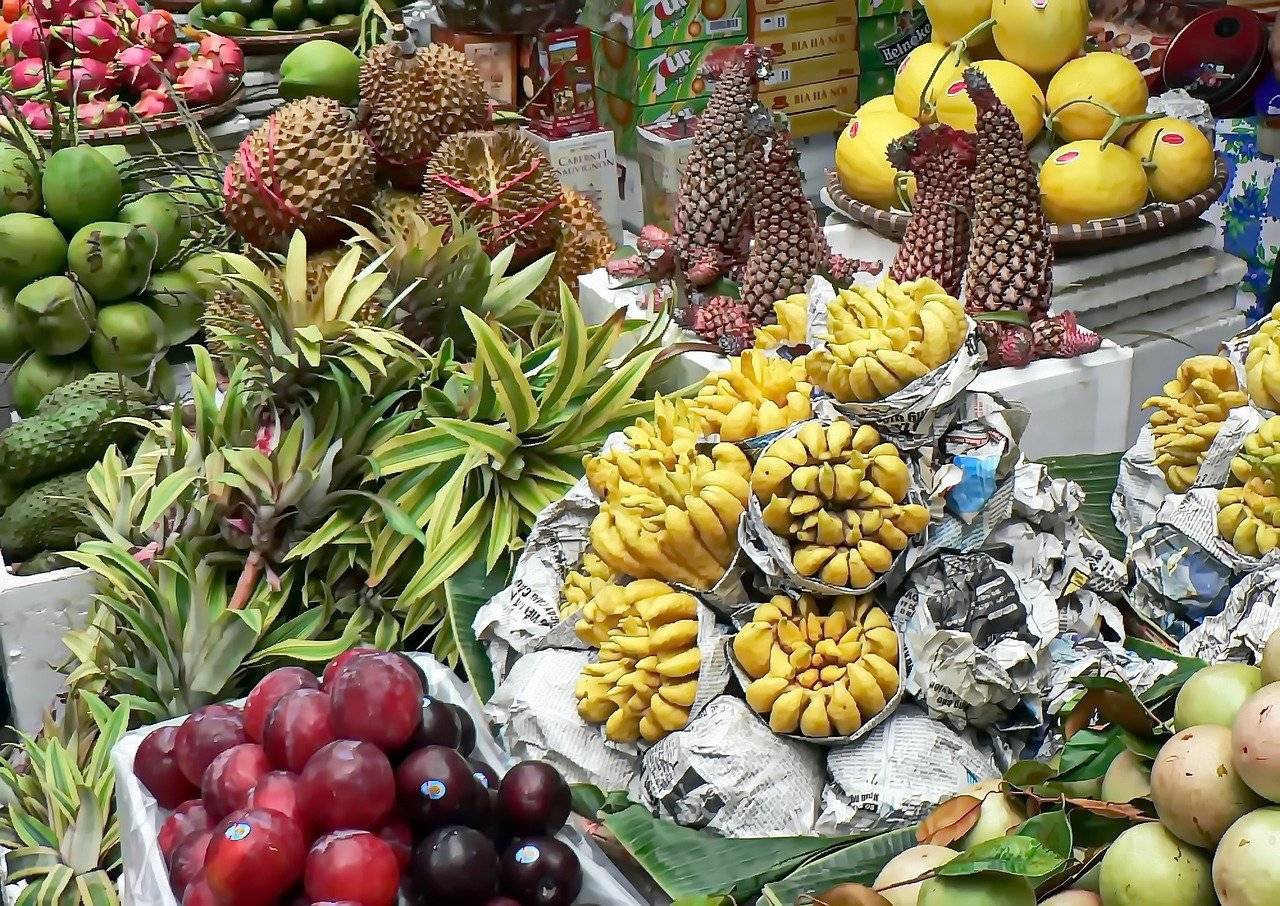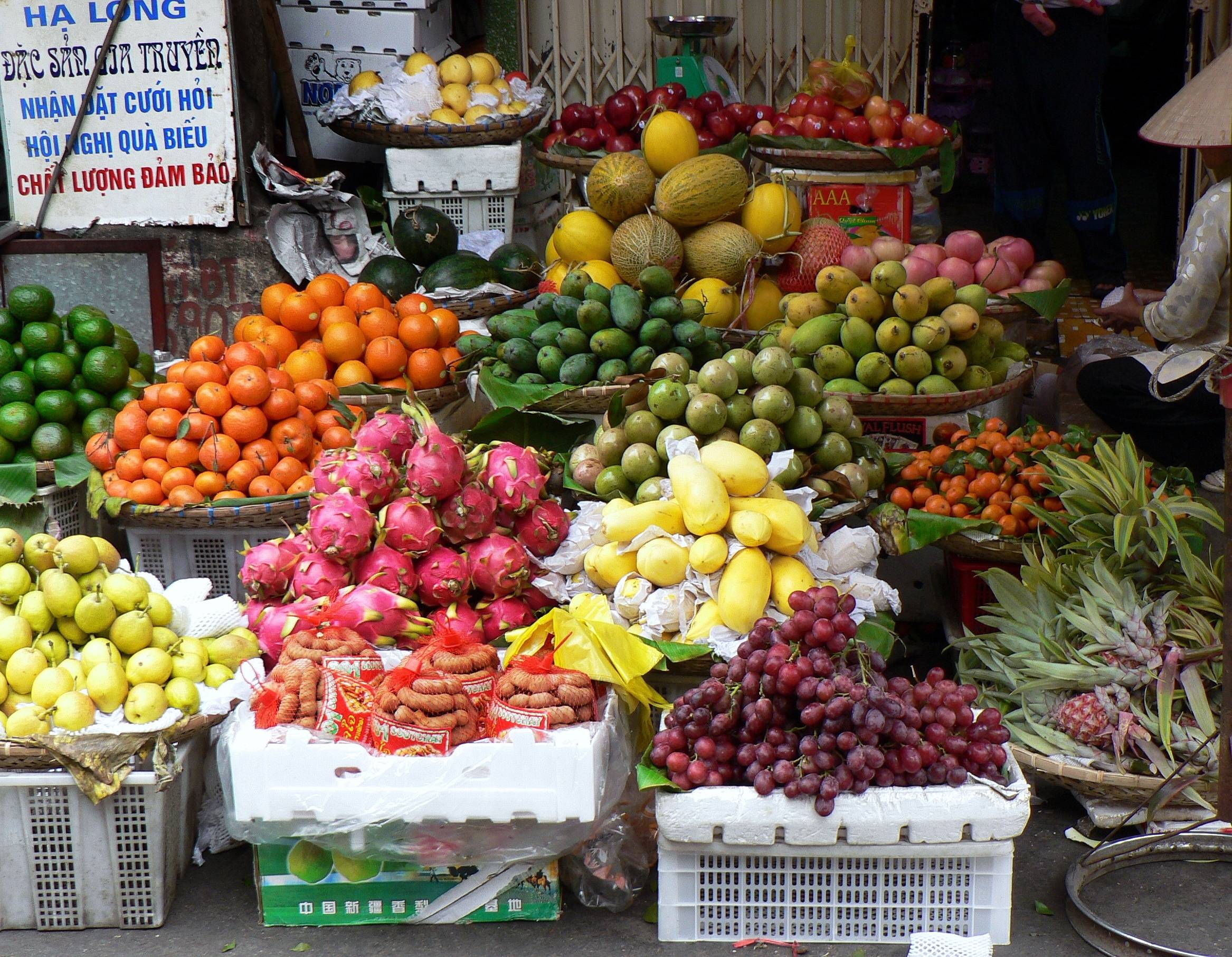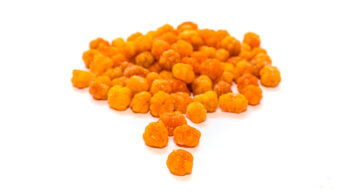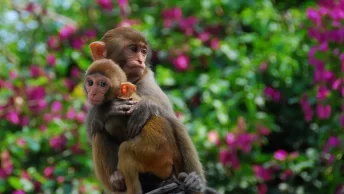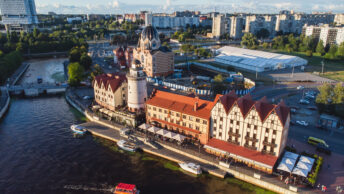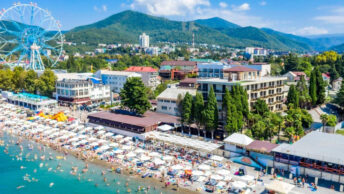10 Vietnamese Fruits You Likely Don’t Know About
To assist you as you travel through Vietnam and SE Asia – here’s a little more information about the fruit in Vietnam that you’ll see. Don’t be afraid to spend the spare change, haggle on a price and try some of these delicious new fruits! (I’ve included the English and Vietnamese name on all of the items!)
1. Bumpy Apples: Mang Cau Tamg
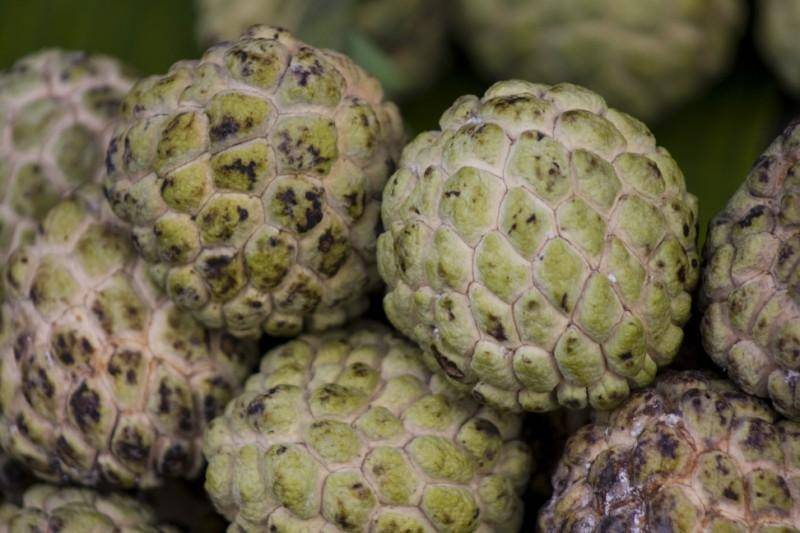 bumpy apples: mang cau tamg
bumpy apples: mang cau tamg
I love Bumpy Apples! The hard outer shells are peeled off and expose a firm apple/pear like fruit that’s very sweet.
2. Mangosteen: Quả Măng Cụt
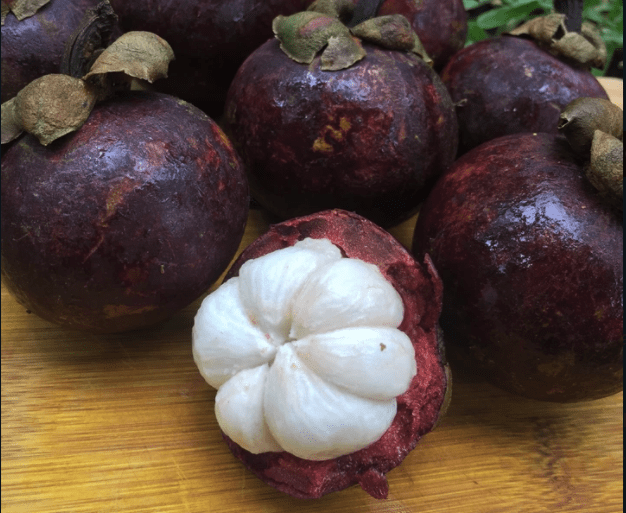
Mangosteen: Quả Măng Cụt
I’ll never forget trying my first mangosteen. I first saw them stacked high on carts along the road and wondered if they were plums. The purple-ish round fruit were completely foreign to me. My friends urged me to try on and I was hooked. You peel off the hard exterior and you’ll find white delicate (somewhat slimy) wedges of fruit with a pit in the middle. They are just the right amount of sweet and like nothing I’ve ever tasted before. And no – they taste nothing like a mango. You just have to try one to believe how delicious they are!
Mangosteens need lots of good sticky humidity to grow, so they are perfect for Vietnam’s climate.
3. Rambutan: Chom Chom
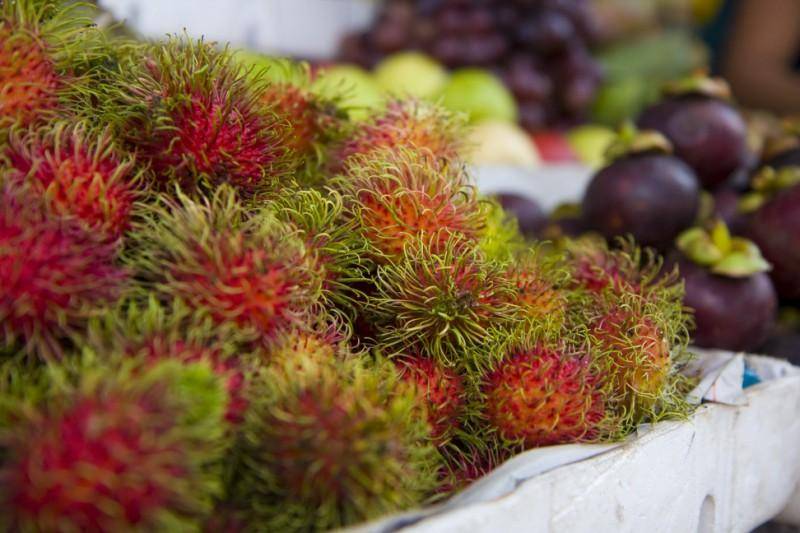 rambutan: chom chom
rambutan: chom chom
Rambutan look a bit scary, but they taste wonderful! It looks as if they live at the bottom of the sea, but they actually come from a tree. Break off the colorful, hairy outer shell and you get to sweet fruit inside that looks like a pear.
4. Water Coconut: Dua-Nuoc
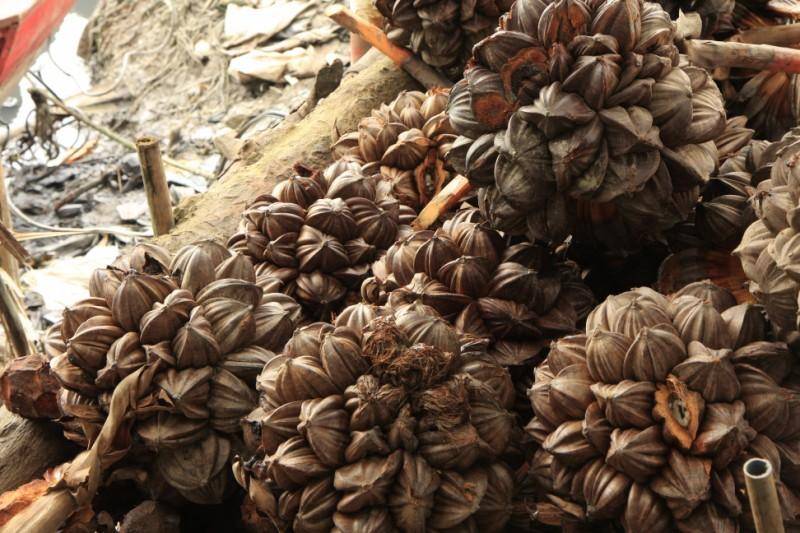 water-coconut: dua-nuoc
water-coconut: dua-nuoc
Water coconut is a relative to the standard coconut. You find these in the Mekong Delta and they taste just like a regular smooth coconut! I have seen these around Saigon for a while now and never knew what they were! They look quite menacing, but don’t’ be afraid to give them a try!
5. Tamarind: Me
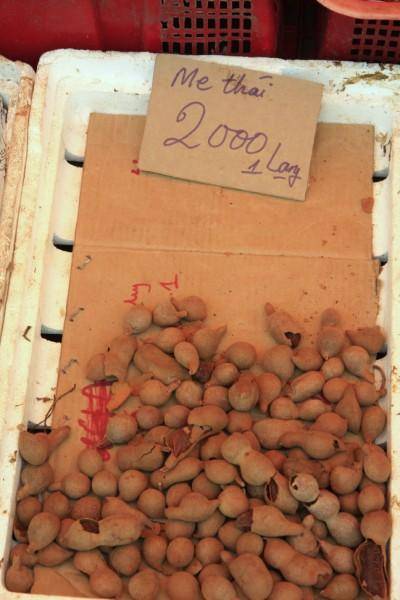 tamarind: me
tamarind: me
Tamarind is used for many things. You’ll often find it used for it’s antioxidant and anti-inflammatory properties. It’s said to be goof to fight off cancer and diabetes in Asia. It can also be eaten plain as a fruit. You just peel off the hard shell and get to a soft, sticky, red fruit with a small pit in the middle. It has a bit of a sweet/sour taste.
6. Persimmons: Hong
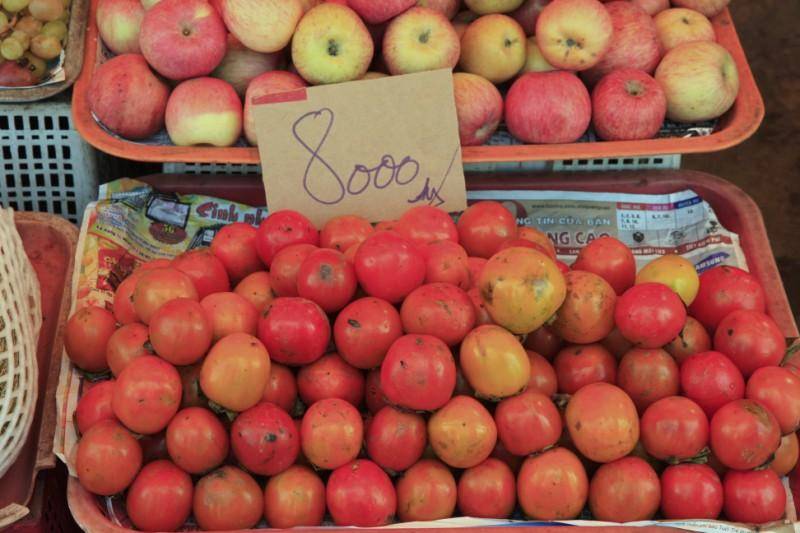 persimmons: hong
persimmons: hong
Persimmons are filling the markets right now. They come from Dalat and are juicy and yummy! They can either be eaten raw, dried, fresh or even cooked. There are a few different varieties – soft or crunchy. I prefer the soft – the texture of a tomato, but taste much sweeter!
7. Longa: Nhan
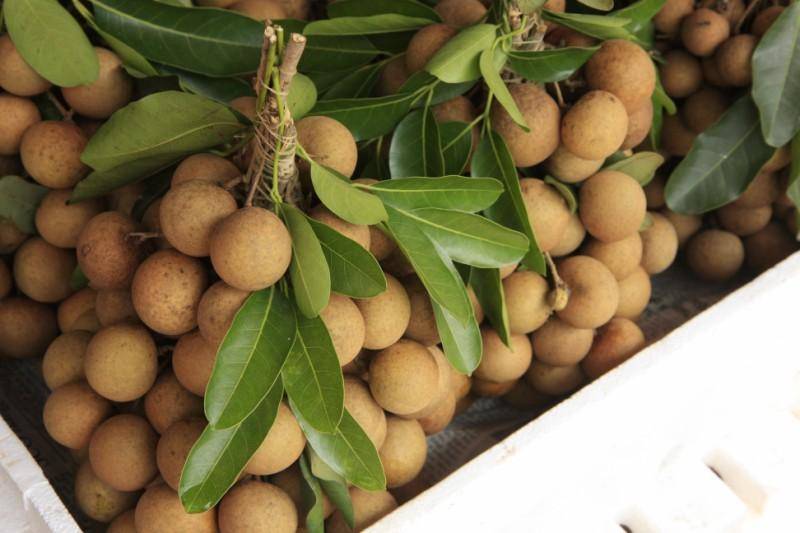 longa: nhan
longa: nhan
For some reason when I eat longa it reminds me of the fall in the US; It tastes like mild cinnamon, cloves, and nutmeg. Peel off the thin outer shell and eat the fruit inside. Good, small, sweet treat!
8. Durian: Sau Rieng
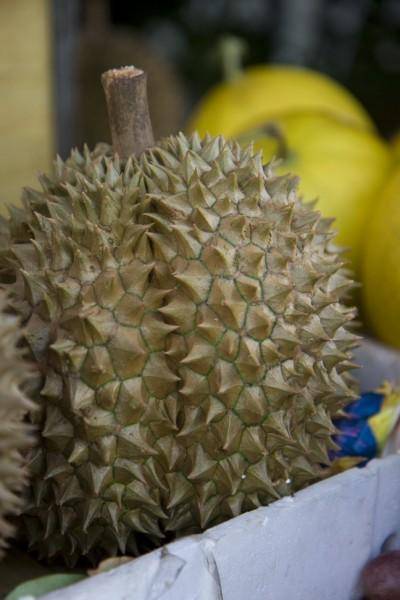 durian: sau rieng
durian: sau rieng
Durian, the king of fruit. You can read about my experience trying durian here. You can find it everywhere in the markets now – or should I say – you can smell it everywhere in the markets now! Eaten alone, in shakes or ice cream – the smelly and squishy fruit is an acquired taste for sure! And I never really acquired it. However, I gave it the old college try – I tried the ice cream, cakes, and tried it raw – and still wasn’t fond of it.
9. Coconuts: Dua
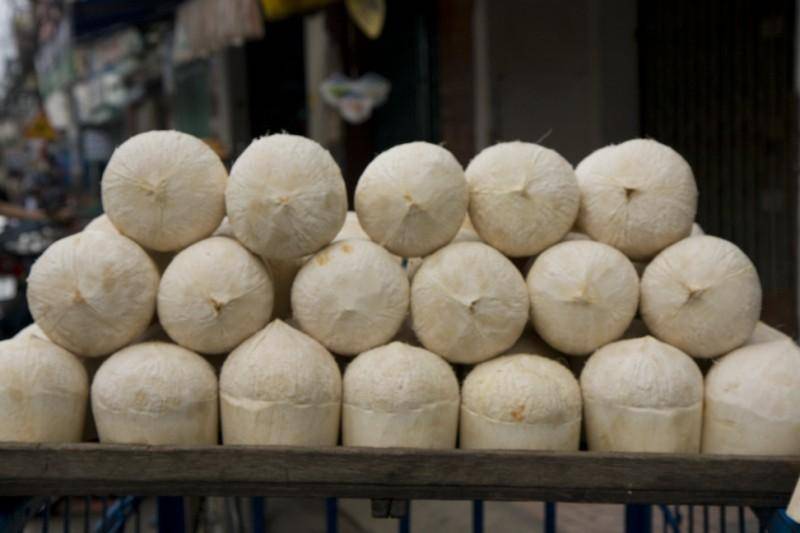 coconuts: dua
coconuts: dua
Ah – my favorite all purpose fruit! Coconuts are everywhere in Vietnam! Cold drinks, jellies, and shakes. Plus, you can’t beat the fresh milk!
10. Dragon Fruit: Thanh-Long
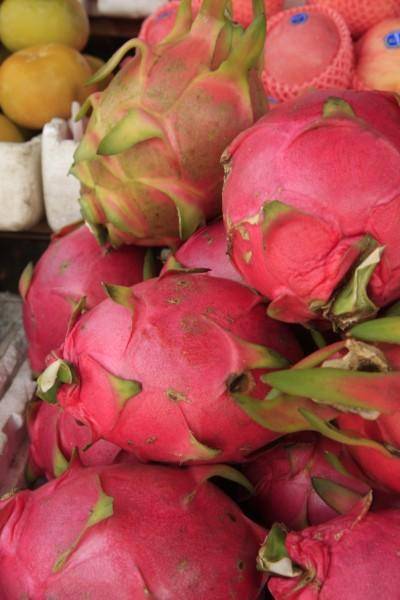 dragon-fruit: thanh-long
dragon-fruit: thanh-long
I still remember seeing endless rows of colorful, pink dragon fruit as I road the bus to Mui Ne. These fruit definitely have personality on the outside – pink leaves tipped with green, but I find the inside a bit bland unless they are eaten in season!
Mystery Fruit
I never did figure out what this strange looking fruit was. Heck, I’m not sure it was even a fruit! Let me know if you see it or find out any more information on it!
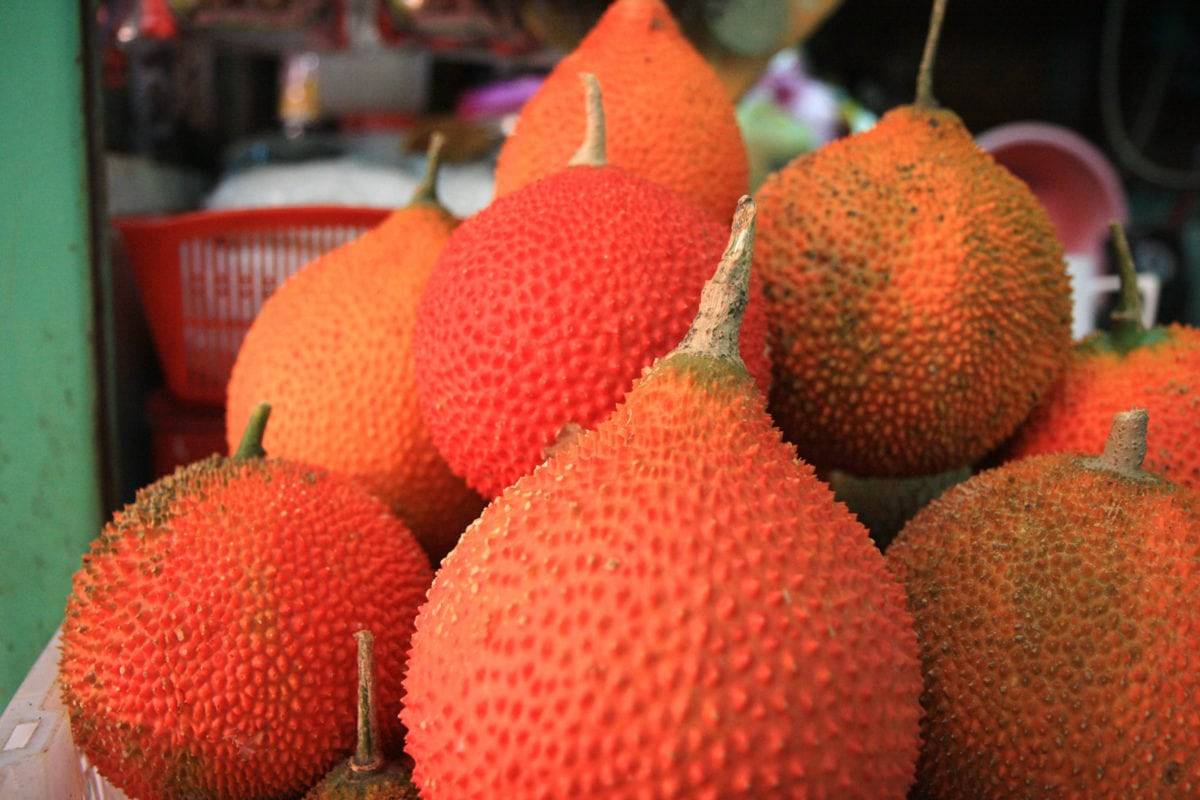
What is this?!
Vietnamese Fruits without Seeds or Pips or with Edible Ones
Coconut
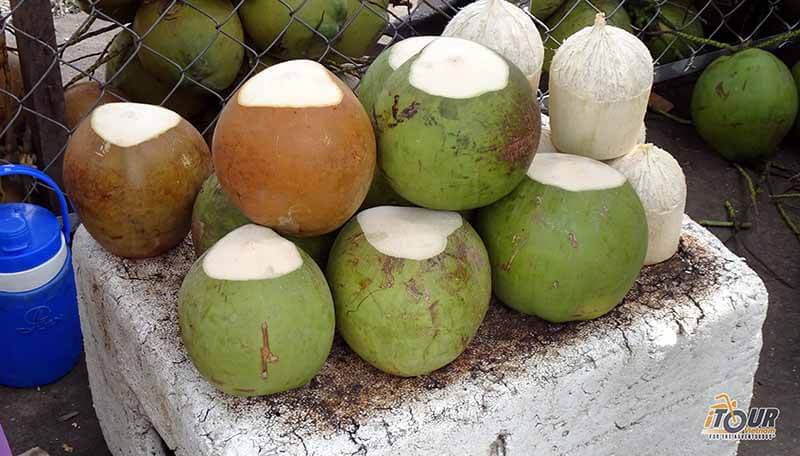
The coconut is one of the tropical fruits that have more water than its flesh inside. Cutting its hard green outer, you will have a pouring delicious fresh drink before getting to enjoy the softly sweet, tasteful meat. It is one of the best fruits in Vietnam to enjoy during the hot summer. Besides, they are sold in almost all Vietnamese locals markets and only cost you about VND 10,000 – 15,000/fruit. All of the parts of the fruit have a variety of uses in cooking such as stewing meat with juice instead of water, braised pork (thit kho trung) making a smoothie, and sweetening the soup. Ben Tre is a “coconut paradise” with the traditional special treat, coconut candy, there was even a time when a religion was established based on this fruit specialty of the area, the relics of which you can still visit when in Ben Tre.
Nipa Palm/Mangrove Palm
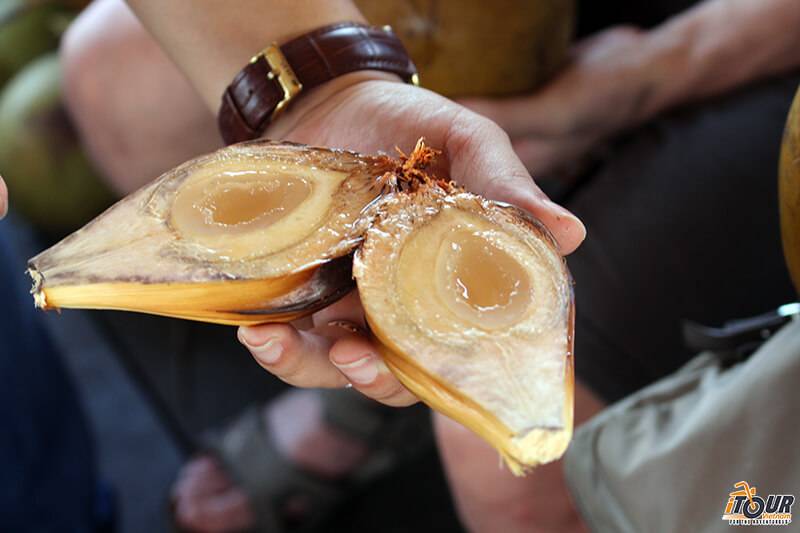
Nipa palm often wildly grows copiously along the banks of many rivers in the Mekong Delta areas. The flesh inside is white with a greasy and syrupy taste. Every bunch of nipa palms in the shape of a spiky ball you see is a combination of small nipa palms with the size of an egg. After taking the nipa palm from its bunch, we use a knife to separate it into two and take a spoon to enjoy the flesh inside. You can also make a refreshing drink by adding sugar syrup into iced water and put a peeled nipa palm in that mix. Other parts of the tree are also used in many ways such as its leaves which are used to build the roof of houses in the countryside or to make a leaf-woven basket.
Dragon Fruit
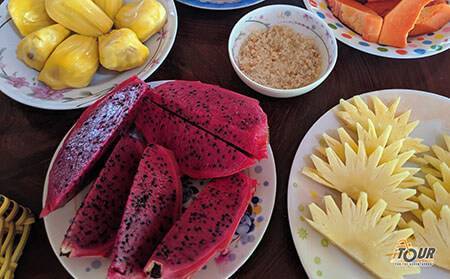
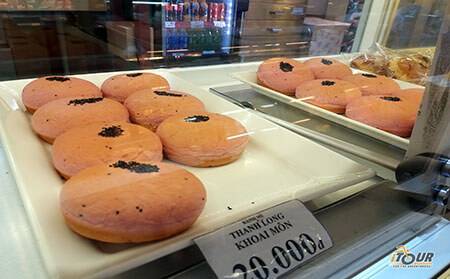
Red dragon fruit can be used to make attractive natural colors for pastries
The dragon fruit is a species of the cactus and grown primarily in the Southern region of Vietnam and particularly in Phan Thiet. To hasten and enhance the growing process, producers use halogen lights to expose the plants for 24 hours. As a sweet, tasty, and refreshing fruit, this is widely popular and available in Vietnam for a price of VND 30,000/kg. This is one of the Vietnamese fruits you should try when in Vietnam.
Banana
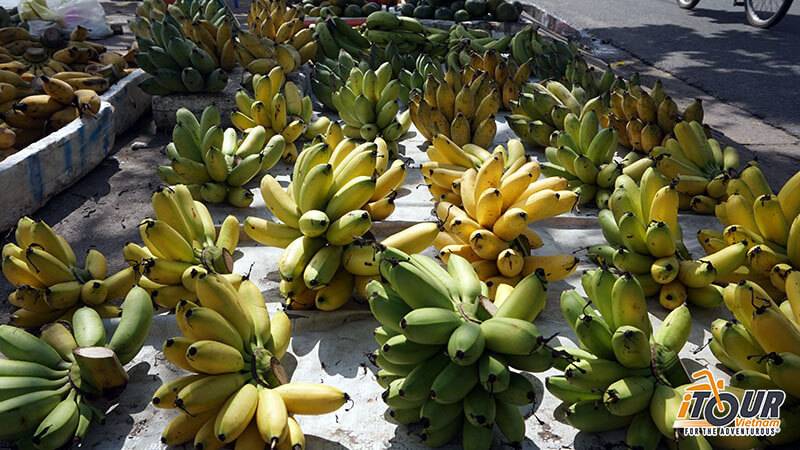
Banana is one of the popular fruits in Vietnam in a daily diet, like in many parts of the world. However, a diversity of bananas just can be found in tropical countries like Vietnam. They are all different in size, color, and taste but all are delicious and healthy. With its distinctive scent, soft pulp, and high in nutrients, banana is an excellent choice of fruits for people in any age group.
Pomelo
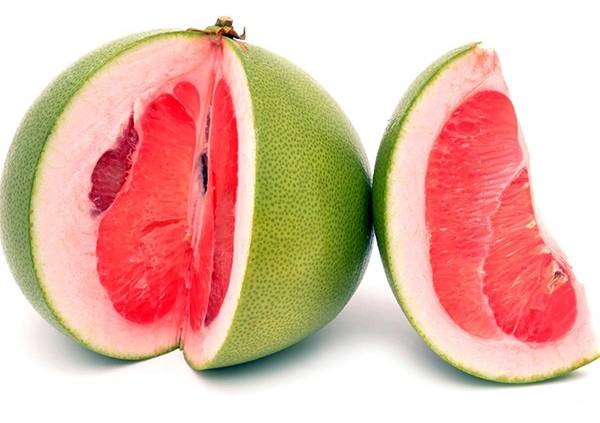
This sweet and juicy fruit is good on its own or in fruits salad. As a good source of Vitamin C, like all citrus fruits, it is thought to reduce blood pressure if eaten regularly. With a market price of VND 70,000/kg, try this Vietnamese fruit chilled or at room temperature.
Pomegranate
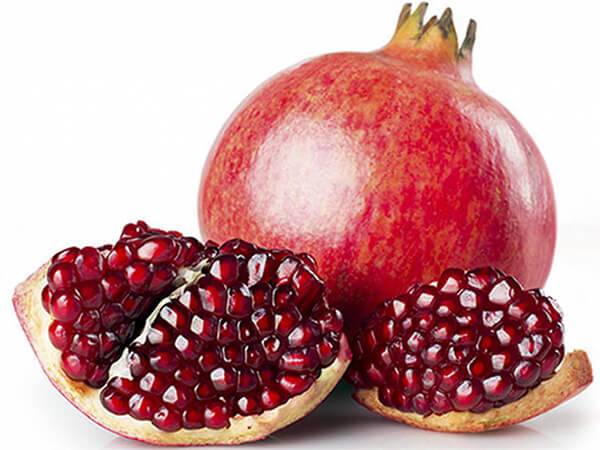
With round red-orange outer, this fruit looks like an onion, but bigger. Its flavor is a bit sour, the fruit combined with lots of fleshy segments covering little seeds inside. Moreover, if you eat it raw or make a drink from this nutritious fruit, your skin may find a bit of benefit from its antioxidants.
Buddha’s Hand/Fingered Citron
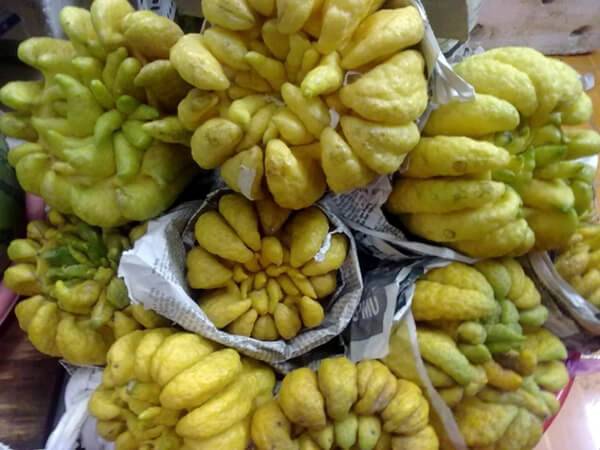
Buddha’s hand is a kind of citron with a unique shape that looks like many fingers are closing in. They have a strong fresh fragrance with yellow skin when ripe at the end of summer. Unlike most fruits and citron, in Vietnam, the fingered citron is usually not eaten raw. It is mostly used to make scented alcohol or jam and to serve as an offering to the Buddha.
Sapodilla
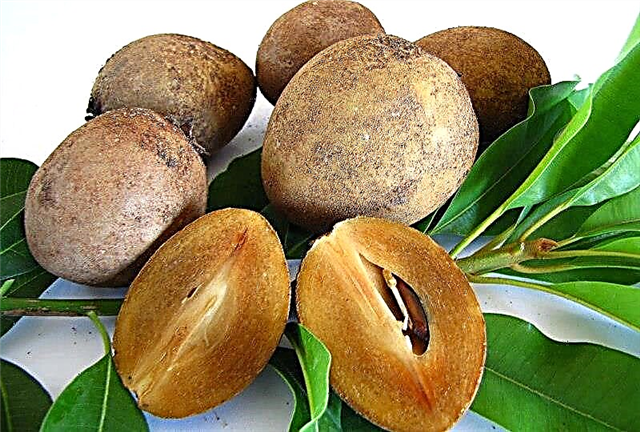
Rounded, light-brown fruits grow on an evergreen tree and reach a diameter of 5-10 cm. Inside, a sweet yellow flesh with a small amount of hard black seeds.
How to determine the ripeness of sapodilla
The ripeness of sapodilla can be easily identified by its soft skin. It tastes like a persimmon, but you should not eat an unripe fruit, because its pulp contains latex, which gives a not very pleasant aftertaste. This fruit is grown in the southern part of Vietnam.
Fruit season: September to December
Useful properties of sapodilla
Useful properties include: It is used to create masks, oils, cosmetic mixtures, shampoos, balms. The content of carbohydrates (23%), crude fiber (20%), the presence of vitamins A and C, vegetable proteins, iron and potassium. The calorie content of sapodilla is 70 kcal for every 100 g.
Качество и стандарты
Вьетнамские фермеры применяют препараты для ускорения созревания плодов или для сохранности свежести плодов в меньшей степени, чем в Китае. В Прикладном биохимическом центре г. Хошимина разработали способ хранения в течение месяца без потери питательных свойств, аромата и цвета. В этом способе химические препараты не используются.
В последнее время большое внимания уделяется стандартизации и экологичности выращивания фруктов. Например, для 16-ти видов фруктов и ягод, поставляемых в США (банан, голубой дракон, дуриан, гуава, слива, личи, лонган, манго, ананас, помело, рамбутан, карамбола, арбуз и другие) существуют санитарные и фитосанитарные стандарты, которые Вьетнам обязался соблюдать при вступлении в ВТО.
При министерстве сельского хозяйства и аграрного развития Вьетнама создан комитет, который дает заключения о возможности применения тех или иных стимуляторов роста и созревания для овощей и фруктов и осуществляет проверку хозяйств, в связи с тем, что некоторые фермеры стали использовать запрещенные супер-стимуляторы, преимущественно, китайского производства. Супер-стимуляторы применяются фермерами в пригородных районах больших городов. Речь, в первую очередь, шла о стимуляторе Ethrel китайского производства. После исследований вьетнамское Агентство по защите растений еще в 2008 г. сделало заключение, что этот стимулятор не внесен в список разрешенных во Вьетнаме, тем не менее, при его применении в допустимых дозах вреда для потребителя нет. Если же он применяется в больших концентрациях, то после употребления плодов, вызревших с помощью Ethrel, появляются аллергические реакции. Например, Центральный институт овощей и фруктов рекомендует фермерам вносить Ethrel в концентрации 5 мл на 1 л воды для ускорения вызревания 10-ти кг манго. Но, часть фермеров вносит большие дозы. В этом случае Ethrel вырабатывает различные кислоты, вредные для желудка.
Фрукты, выращенные во Вьетнаме, несколько дороже, чем китайские. Поэтому в страну импортировалось много фруктов от северного соседа. В 2012 г. ситуация изменилась. При оставшемся соотношении цен вьетнамцы все же стали покупать свои, а не импортные из-за лучшего качества отечественных. Многие крупные торговые сети заявляют, что 95 процентов реализуемых фруктов и овощей произведены во Вьетнаме. Остальные 5% приходятся на те фрукты, которые почти не выращиваются во Вьетнаме, например, киви и виноград.
Минсельхоз Вьетнама в южном регионе страны организовал сезонное регулирование выращивания пяти фруктов: манго, лонгана, драконьего фрукта, дуриана и рамбутана. С помощью биотехнологий различные хозяйства будут вызывать цветение деревьев в разное время, что позволит собирать урожай более распределенно по месяцам года. Вероятно, и отгрузка на экспорт одного и того же фрукта будет происходить почти круглый год.
Bon Bon Fruit | Lòn bon
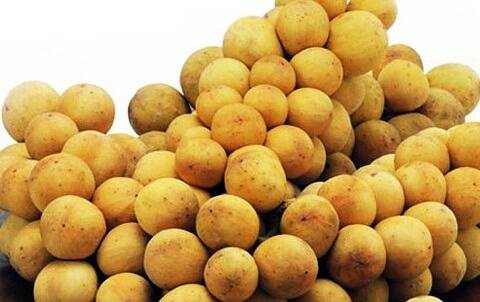 Bon Bon Fruit
Bon Bon Fruit
Bon Bon Fruit in Vietnam has a milky-white color with double size of a finger. Its flesh gets a sweet taste and many zones and bitter seeds. So, when eating bon bon, you should not bite their pips.
Bon Bon (in some places also bòn bon, lòn bon in Vietnamese) has the scientific name of Lansium domesticum, belonging to the Meliaceae family. According to nutritionists, every 100 g of bonbon contains 0.8 g of protein; 9.5 g of carbohydrates; 2.3 g of fiber; 20 mg of calcium; 30 mg phosphorus; 0.089 mg thiamine; 1 mg ascorbic acid and quite a lot of vitamin A.
Bon Bon Fruits also contain sugar, fiber, fat, protein, vitamins B1, B2, B3, C, E that are considered as antioxidant substances, which helps the body eliminate free radicals leading to Cardiovascular diseases, strokes. Also, minerals such as Ca, Fe, P … help increase red blood cells and prevent anemia.
And, thanks to containing rich thiamin and riboflavin that bonbon is very good at fighting migraines, and niacin reduces bad cholesterol, increases good cholesterol in the blood.
When eating Bon Bon, you choose a good fruit that is a medium size, neither large nor small, just a little bigger size than a thumb, yellow-white skin, and round. Do not select big fruits because the seeds are large, often sour, and those with dark spots do not eat well.
Tien Phuoc district (in Quang Nam province) and Dak Lak (in the Central Highlands) are the main areas growing Bon Bon. But, now some provinces in the Mekong Delta also cultivate it. The harvest season of Bonbon is October to December.
The price of Bon Bon: 30,000 – 50,000VND
Видео: Экзотические фрукты Вьетнама
Рамбутан
Плода рамбутана представляют собой волосатые шарики ярко-красного цвета с наличием внутри матовой жидкости и довольно большой косточки. По вкусу напоминают личи и отличаются свежестью, сочностью. Фрукт хорошо выводит из организма шлаки и токсины. Период созревания с мая по октябрь.
Мангостин
Плоды магностина по внешнему виду напоминающие шарики темно-фиолетового цвета с твердой оболочкой с наличием внутри молочно-белой мякоти с небольшой кислинкой, содержащей витамины группы С, В1.
Кожура плода также обладает полезными свойствами, а отвар из нее устраняет диарею, угревую сыпь, обладает антибактериальным действием. Сезон созревания с мая по июнь.
Личи
Личи является деликатесом, который выращивают на севере Вьетнама. Плоды имеют вид красно-розовых шариков с шероховатой поверхностью, имеющих тонкую кожуру и мякоть белого цвета сладкую на вкус.
Плоды полезны для организма, так как усиливают потенцию, улучшают процесс пищеварения, понижают уровень холестерина, нормализуют кровообращение в головном мозгу. Период созревания с мая по июль.
Мандарин
Вьетнамские мандарины имеют характерный вкус сладости, сочности, так как получают достаточное количество солнечного света. В составе содержатся витамины группы А, С, Д , большое количество клетчатки оказывающей благоприятное воздействие на процесс пищеварения и перильстатику кишечника.
Кремовое яблоко
Плоды фрукта имеют немаленький вес до 1,5 кг и растут на высоких деревьях, а по внешнему виду жесткую кожицу коричнево-красного цвета и мякоть кремового оттенка с несъедобными семенами.
На вкус мякоть имеет характерную сладость с оттенком хвои, а в составе содержится максимальное количество витамина В. При употреблении фрукта улучшается зрение, снимается головная боль, увеличивается умственная активность.
Звездное яблоко
Звездное яблоко во Вьетнаме называют «грудным молоком» и фрукт выращивают в местных садах одинаковых размеров. Семена внутри плода напоминают звезду, сок молочного цвета, сладкий на вкус.
Способ поедания фрукта:
- плод мнут в руках для смешивания мякоти с соком;
- небольшое отверстие проделывают в верхней части плода;
- высасывают содержимое плода.
Плоды дракона
Экзотический фрукт Вьетнама, имеющий второе название питахайя (сердце дракона). Растение из рода кактусовых, спелые плоды с оболочкой ярко-розового цвета и наличием внутри белой мякоти с черными точками (семенами).
Вкус фрукта немного пресный с кислинкой, напоминающий землянику. Сбалансированный состав обеспечивает укрепление иммунной, эндокринной системы, рекомендовано употребление при сахарном диабете. Мякоть используют в косметологических целях для приготовления шампуня, крема, лосьона.
Карамбола
Экзотический фрукт в виде звезды ярко-желтого цвета по вкусу напоминающий смесь яблока, винограда, огурца и хорошо утоляющий жажду в жаркую погоду. В составе содержится большое количество углеводов, витамины В1,В2, В5, С, кальций, фосфор.
Употребление карамболы быстро устраняет признаки авитаминоза в организме. Невысокая калорийность плодов позволяет употреблять их во время соблюдения диеты.
Помело
Помело в многочисленных количествах произрастает на территории Вьетнама (особенно дельта реки Меконг). Спелые плоды имеют шаровидную форму и характерный цитрусовый аромат с весом до 10 кг.
Кожура толстая, мясистая салатового цвета, мякоть распределена в дольках от розового до ярко-красного оттенка. Вкус сладковатый с горчинкой напоминающий грейпфрут. Плоды обладают невысокой калорийностью и полезным составом.
Лонган
Лонган выращивают в северных провинциях Вьетнама и считают королевским фруктом. Гроздья плодов в виде шариков светло-коричневого цвета располагаются на тонких ветках дерева. Внутри белая и сочная мякоть с косточкой. Из фрукта готовят деликатесный суп, подают его в сушено виде без косточки.
Хурма
Хурма довольно популярна во Вьетнаме, имеет обычный вид в виде плодов шаровидной формы яро-оранжевого цвета с вязким и сладким вкусом. В составе имеется максимальное количество витамина С, а употребление фрукта способствует снижению давления. Нормализации работы пищеварительной системы.
Саподилла
Саподилла произрастает в южных провинциях Вьетнама в садах на вечнозеленых деревьях.
Плоды имеют бурый цвет с мякотью оранжевого оттенка, по вкусу напоминающей хурму. Фрукт широко используют в косметологии (приготовление шампуня, бальзама). Сезон созревания с сентября по декабрь.
Mangosteen | Măng cụt
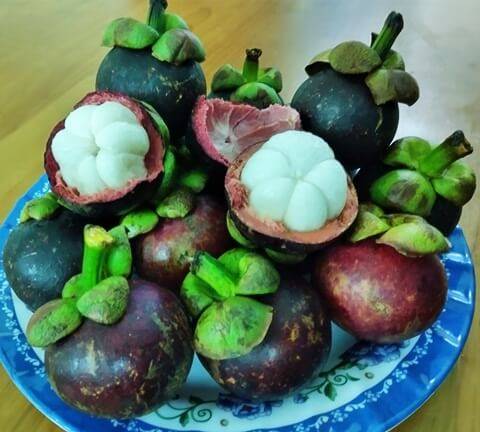 Mangosteen | Măng cụt
Mangosteen | Măng cụt
Mangosteen is a common fruit in Vietnam as well as in Thailand, Malaysia, and Indonesia. Mangosteen trees are very big, they can reach up to 10-meters height.
When mangosteens get ripe, they have a dark purple color. Mangosteen gums are white in color and divided into many zones with a sweet and slightly sour taste and special aroma.
In Vietnam, the farmers grow a lot of mangosteen trees in the Mekong Delta provinces. These plants have a good value for the economy. The eaters voted it as “the queen of tropical fruit tree” because of their beautiful shape and delicious nutritious taste.
Cho Lach mangosteen, a special of the Ben Tren province (the Mekong Delta, Vietnam), has been famous for many people. Cho Lach district has 1,200 hectares to grow mangosteen.
The harvest season of Vietnamese mangosteen is from mid-April to June. This fruit has a different size. When you want to taste them, you should choose a small and medium size. It’s because big size also has large seeds.
The price of mangosteen: 50,000 – 90,000VND/kg
As the same with any fruits, although mangosteens have plenty of vitamins good for health, you should not eat them much, because they can cause allergic reactions, and interfering with blood coagulation.
Дуриан
Из-за не очень приятного запаха его запретили перевозить в самолетах, многие заведения общественного питания даже имеют на двери таблички с изображением перечеркнутого дуриана. Вкус его мякоти многие гурманы оценили достаточно высоко, он напоминает фруктово-ягодный йогурт. Проникнув под толстую зеленую кожуру с острыми шипами, надо просто поторопиться, пока запах не стал резким. Происходит это из-за того, что он содержит летучие соединения серы.
Сезон: с мая по ноябрь.
Полезные свойства дуриана
Будьте осторожны, если у вас гипертензия, так как он повышает кровяное давление. Дуриан очень питателен. Также этот фрукт способствует выведению вредных веществ из организма. В народной медицине его используют для снижения температуры тела и против желтухи.
Как определить спелость дуриана
Есть два надёжных способа. Во-первых, сделать это можно по запаху, который исходит от хвостика фрукта. Чем он более яркий и неприятный, тем лучше. Во-вторых, ориентируемся на звук. Берём что-нибудь подходящее и простукиваем плод. Булькающий звук указывает на зрелость дуриана, пустотный на то, что плод ещё не дозрел.
Starfruit / Carambola
Starfruit is just as magical as it sounds. The starfruit trees bloom twice a year, however at very unpredictable times so there is no set season for them. When ripe, the starfruit turns a golden color. The outer skin is quite thin and waxy but is edible. When cut horizontally you will receive perfect star-shaped slices, hence the name starfruit. The inside flesh is golden yellow and very juicy but its taste is unmatched. Some say that it is a mix of citrus fruit, grapes, and the texture of an apple, but you will have to try it yourself to truly know!
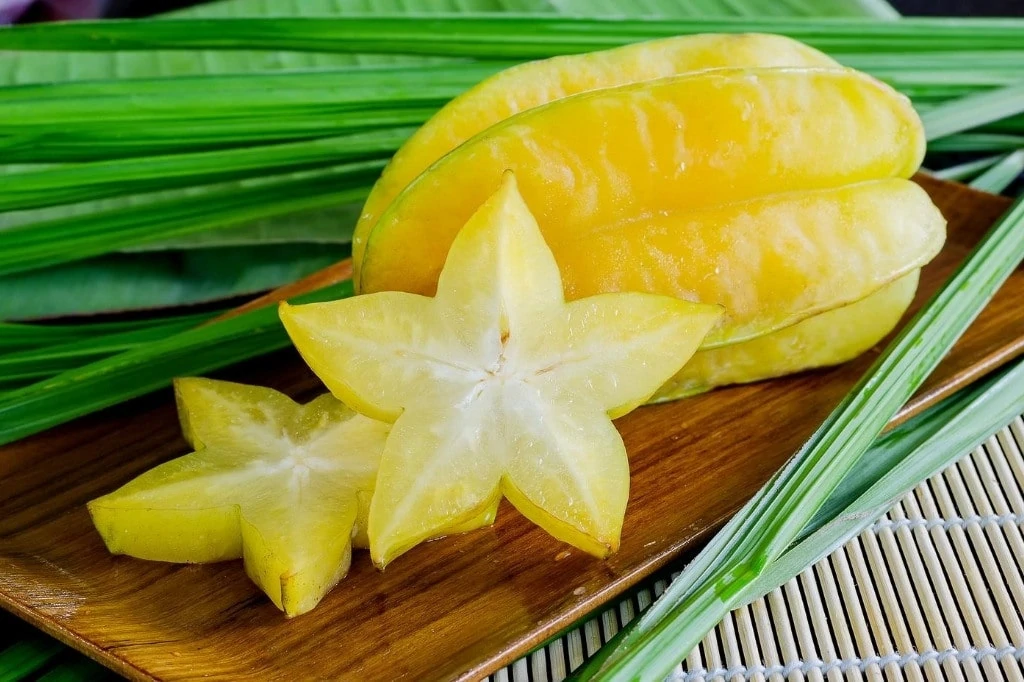
Starfruit or Carambola fruit on wooden plate – by DevMarya/GettyImages
The starfruit is known to have strong anti-inflammatory products. It also has properties to promote weight loss, improve digestion, monitor blood pressure, and possibly even reduce cholesterol levels. It is rich in Vitamin A, B, and C along with minerals like zinc, iron, magnesium, and potassium.
How to Eat a Starfruit?
Starfruit is very easy to eat, all it requires is a quick rinse of the waxy skin before consumption then you can dig in. If you want some added magic, slice the fruit into its unique starry shape.
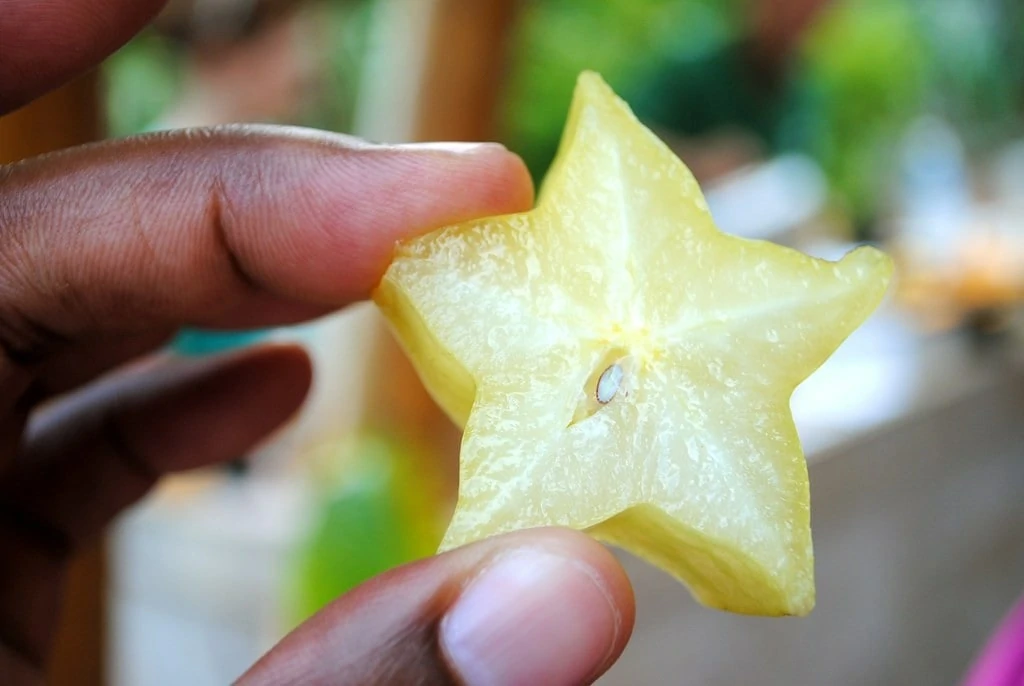
A slice of star fruit. This one was very juicy, but not sweet – by Bob B. Brown (CC BY-ND 2.0)
This is a very popular aspect of Vietnamese cooking. It is often used for a sweet addition to a summer salad or to a curry. You can also make various desserts like cakes, ice cream, and chips. You can often find starfruit as an interesting addition to cocktails or drinks.
Where to Find Starfruits in Vietnam?
Starfruit is one of the more difficult fruits to find in Vietnam due to its limited and very unpredictable season. It is available year-round in the Mekong Delta due to its perfect growing climate. You can also count on finding it in many local markets or even littered onto the streets in central Vietnam from the fruit trees littered around the cities.
The average price for 1 kilo of starfruit is 20,000-30,000 VND.
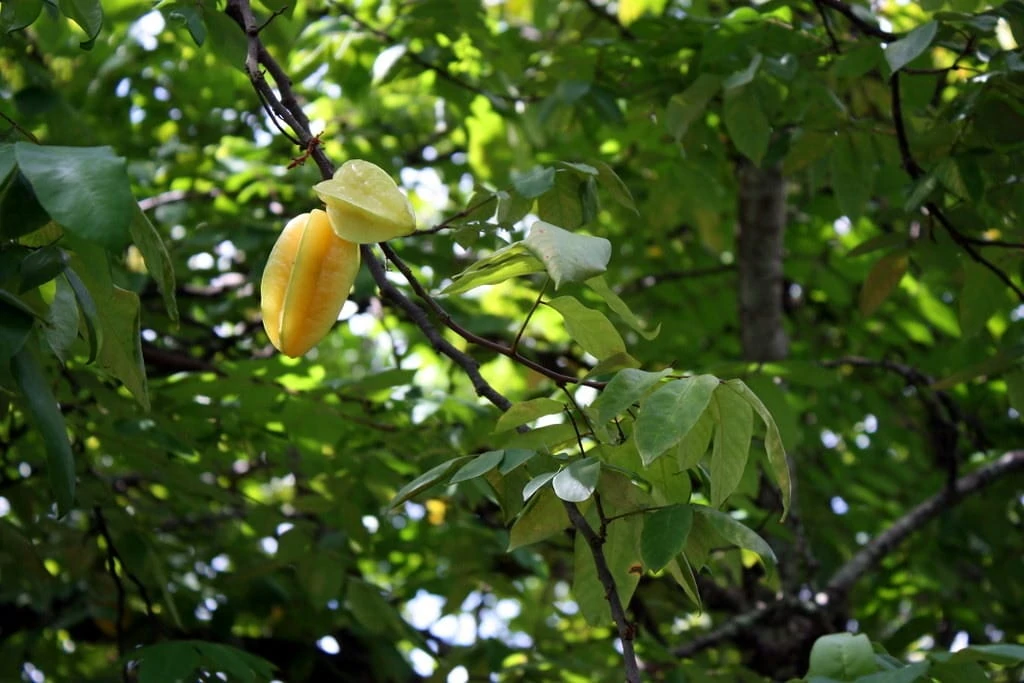
The starfruit is the fruit of the star fruit ( Averrhoa carambola ), a small ornamental tree, of the Oxalidaceae family – by Márcio Cabral de Moura (CC BY-NC-ND 2.0)
Dragon Fruit / Pitaya
The dragon fruit has another unique look, like many tropical fruits. The fruit is even named after its interesting look, for many believe the fruit resembles a dragon’s head. The outer skin is a thick pink rind with short green tentacles spreading slightly up and outward. Inside of the skin, the flesh comes in two colors of either white or pink, dotted with hundreds of small edible seeds.
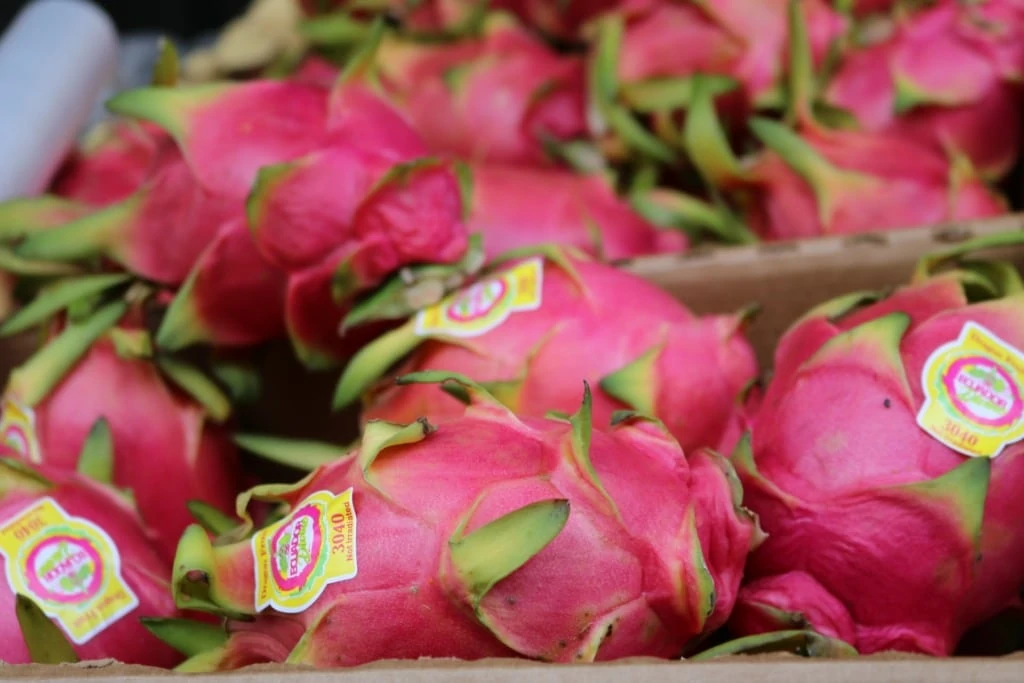
This is not one of the most flavorful fruits Vietnam has to offer it tastes quite water-like. However, this fruit is a great palate cleanser and great for your health. It is said that the pitaya fruit comes with many different health benefits and many nutrients. The highest concentration of nutrients can be found in the pink flesh dragon fruits.
How to Eat a Dragon Fruit?
The skin of the dragon fruit is easy to peel off and eat piece by piece. Or you can slice up the dragon fruit with a knife and remove the skin that way. My personal favorite way of consuming dragon fruit is either by a smoothie bowl or by cutting the raw fruit up and squeezing a lime over the top for the extra tang of flavor.
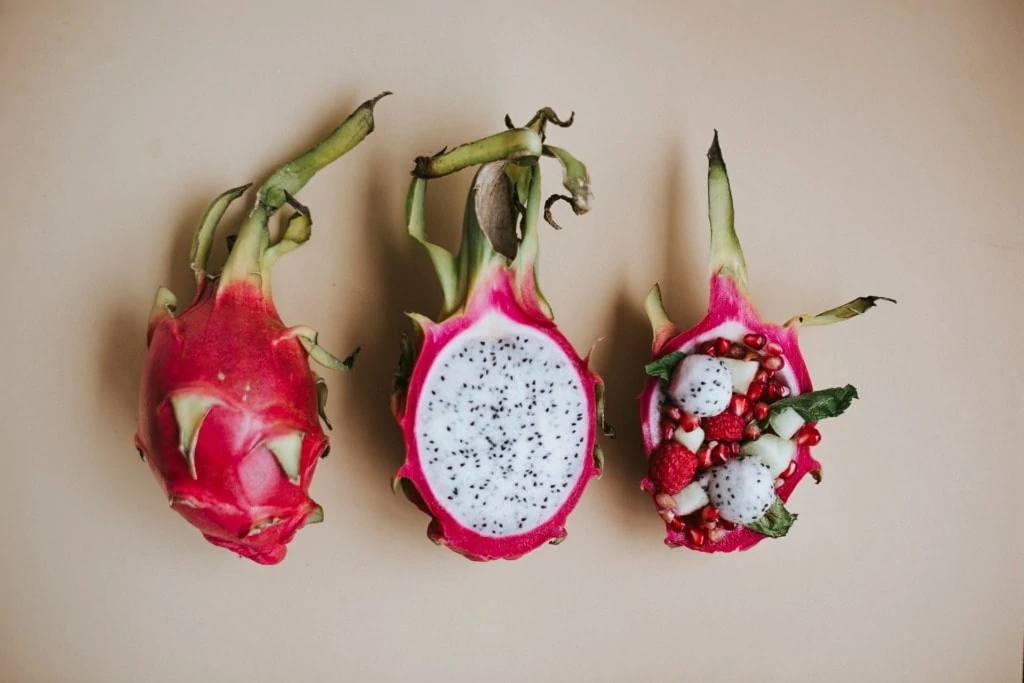
Dragon fruit is not used in many cooking recipes due to its bland flavor, but it is used in various salads, smoothies, and other healthy treats for a boost of fresh taste and nutrients.
Where to Find Dragon Fruit in Vietnam?
Dragon fruits are available throughout the country year-round! It is one of the few fruits that you can find everywhere all the time! Although, sometimes the price does vary during the slower times of the year.
Binh Thuan province is said to produce the best dragon fruits due to its superior climate, and are shipped around the country from here. There are also lots of local dragon fruit farms, however, most aren’t operated year-round. You can find dragon fruit at any local Vietnamese market, and at most large supermarkets.
The average price for 1 kilo of dragon fruit is from 25,000VND to 40,000 VND depending on what kind you get.
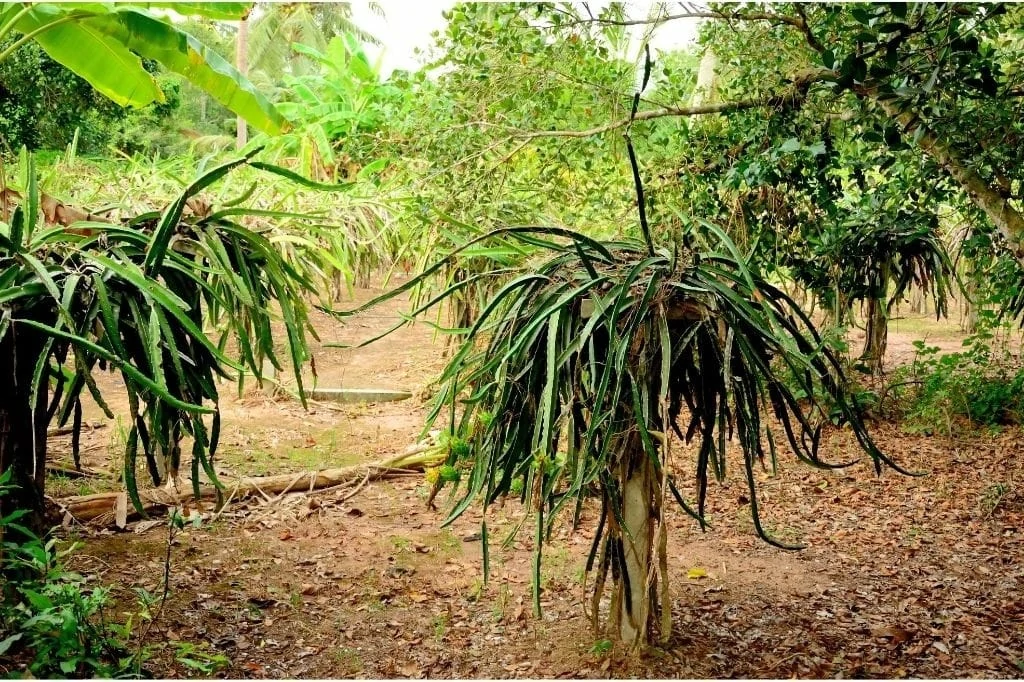
Dragon fruit farm in Vietnam – by pixbox77/GettyImages
Видео: Фрукты Вьетнама дуриан и джекфрут
Папайя
Папайя произрастает на территории Вьетнама круглогодично, а по вкусовым характеристикам напоминает дыню. В составе фрукта содержится максимальное количество витамин группы А, С. Спелые плоды рекомендовано употреблять после еды.
Фрукт обладает немалым числом полезных свойств (улучшение пищеварения, выведение токсинов, укрепление иммунитета, повышение циркуляции крови). Созревшие плоды имеют ярко- оранжевую окраску с нежным и сочным вкусом мякоти.
Ананас
Ананас, выращенный во Вьетнаме и сорванный в созревшем состоянии, имеет другой вкус (повышенная сочность и сладость) в сравнении с фруктом, который продают в наших супермаркетах.
В составе содержатся незаменимые полезные вещества, микроэлементы, компонент «бромелайн», способствующий сжиганию жиров в организме, поэтому его используют при изготовлении различных средств для похудения.
Гуава
Плоды гуавы имеют грушевидную форму с ярко-зеленой кожурой и красной мякотью с большим количеством семян расположенных в сердцевине фрукта. Размеры до 15 см в диаметре. Во Вьетнаме спелую мякоть поедают с красным перцем и солью.
В составе фрукта содержатся редкие микроэлементы (сера, цинк, марганец, йод, фосфор, витамины группы А, В, С, К), которые обеспечивают укрепление иммунитета, повышение тонуса, стимулирование работы сердечной мышцы, положительное воздействие на лимфатическую систему.
Mangosteen | Măng Cụt
If you happen to travel in Vietnam between May and August, then you’ll get to try mangosteen, one of the most delicious fruits on the planet. Gently squeeze the purple shell in order to break the skin. Then, pull out a pod of white fruit – which incidentally look like garlic cloves, but don’t let that put you off – and get ready to taste a real delicacy. If you’ve ever tasted candy called ‘Refreshers’ in the West, a mangosteen tastes exactly like the purple ones. We kid you not!
It can be tricky to buy perfectly-ripe mangosteen as a little knowledge regarding their texture is needed. If you can take a local friend to the market with you, ask them to show you how a ‘just right’ mangosteen feels. There should be a little ‘give’ when squeezing, but not too much. You can also check the base of each one – you’ll see a shape here that looks like the flattened petals of a flower. The number of ‘petals’ will tell you how many segments of fruit you’ll get inside. Six is a good number when it comes to these delicacies.
Nutrition: mangosteen works as an anti-inflammatory
Dragon Fruit, Mangosteen, & Rambutan
Breadfruit
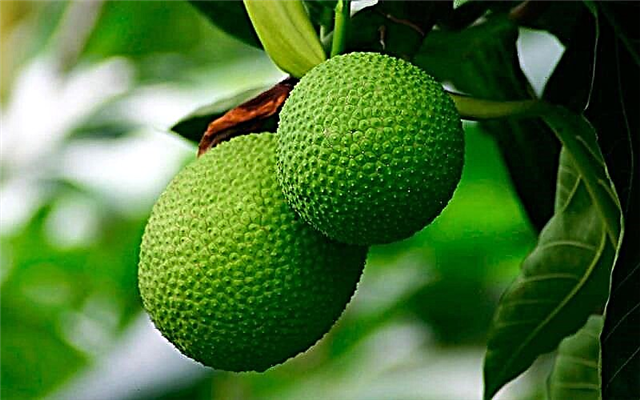
One of the most unusual fruit trees is bread. Its fruits can replace both vegetables (unripe) and fruits (when the fruit is fully ripe). Often the dimensions reach 40-50 cm in diameter and weigh more than 30 kg. Outwardly, there is a resemblance to durian, but the rind of the breadfruit is abundantly studded with thorns. Inside is the pulp, divided into slices, in which large bones are found. It tastes like a mix of melon, pineapple and banana aromas.
Fruit season: January-May.
How to determine the ripeness of a breadfruit
Ripeness is determined by skin color and smell. The more ripe the fruit, the brighter its yellow color, and the smell resembles onion or even garlic.
Useful properties of breadfruit
The benefits come from a combination of nutrients, vitamins, calcium, acids and minerals. Substances are useful for the skin, nervous system, prevention of heart disease. The high content of vitamin C gives it antiviral properties. It is believed that moderate consumption of breadfruit fruit prevents premature aging, cancer cell formation, and thyroid disease.
Карамбола (ма-феонг)
В наших широтах фрукт-экзот используют для украшения блюд: поперечный срез карамболы похож на звездочку. Ну а в Таиланде его просто едят, наслаждаясь сладким вкусом с приятной кислинкой. Карамболу можно не чистить, а есть вместе с кожурой.
Сезон: октябрь-декабрь.Полезные свойства: высокое содержание витамина С, бета-каротина, витаминов группы В, микроэлементов. Обладает кровоостанавливающим, противодиарейным действием.Как выбрать: для еды выбирайте желто-зеленые, мясистые, но не слишком мягкие плоды с коричневой полоской вдоль ребер. Запах у спелой карамболы – цветочный, немного похож на запах жасмина
Недозревшая карамбола кислая, ее можно использовать для приготовления салатов и мясных блюд.Обратите внимание: в карамболе содержится щавелевая кислота, противопоказанная при язве и гастритах
Lychee
Lychee is a personal favorite fruit of mine, and are a must-try fresh snack when visiting Vietnam!
Lychee is originally grown in southern China and is a favorite fruit of many local people in southeast Asia. Once long ago, this fruit was reserved as a precious item only for the royal people. The Lychee fruits are easily recognizable with a hard red skin around the small fruit and are sometimes textured into dull spikes. Once you remove the skin you will find a translucent white and thick jelly-like flesh similar to rambutan. The taste is sweet and refreshing.
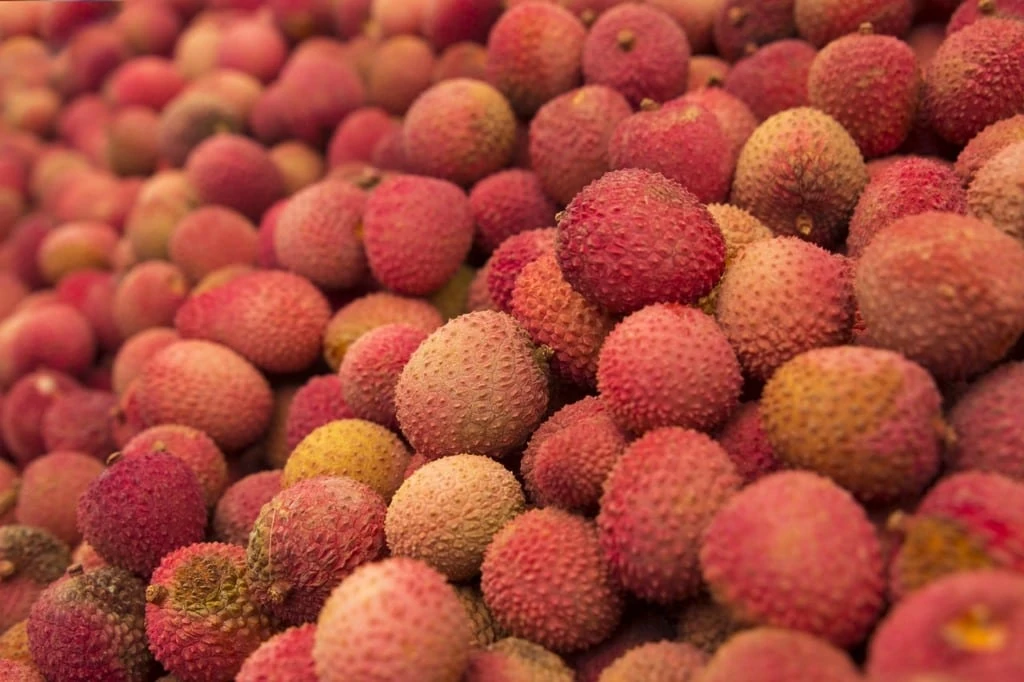
These fruits can be quite addicting and soon you’ll be eating them like candy. Lychee has many different health benefits and is even considered to be a natural pain relievers. Lychee is also great for your skin and hair due to its large amount of B vitamins.
How to Eat a Lychee?
The best way to eat lychee is as a snack, simply peel off the skin and eat the skin around the seed. These fruits are an easy snack to take anywhere. Beyond their raw form, lychee is used in a lot of dishes like fresh salads, jams, pastries, cocktails, and even used in some meat dishes. The season for these dishes is very limited to the lychee season, so if you’re looking to try some of these out, May is the perfect time.
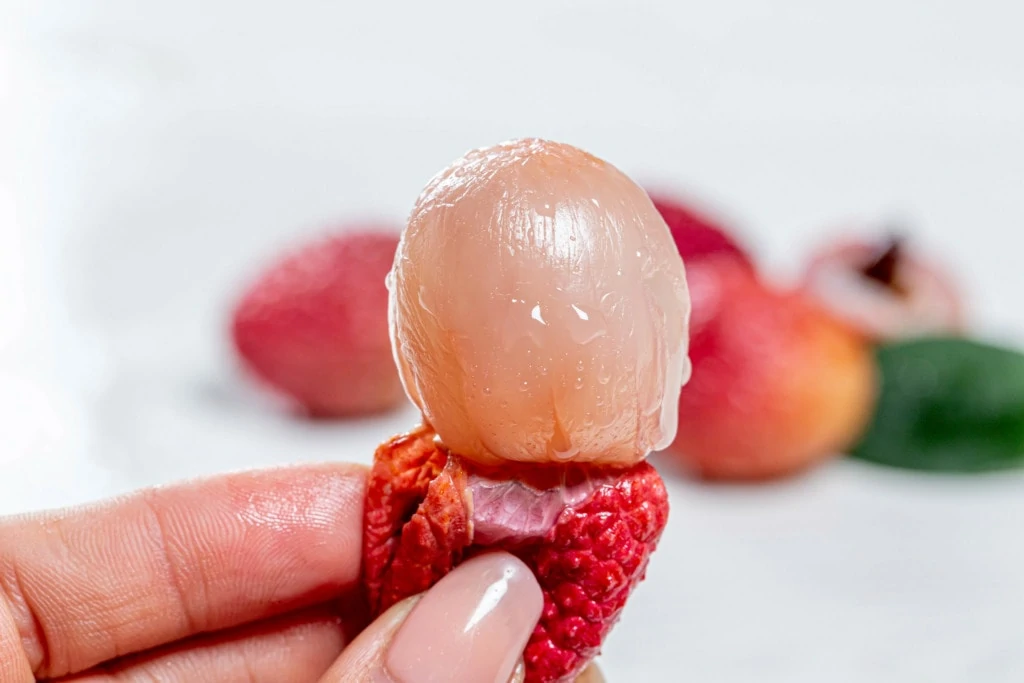
Lychee fruit pulp without peel in a woman’s hand – by Marco Verch Professional Photographer and Speaker (CC BY 2.0)
Where to Find Lychee in Vietnam?
The most delicious lychee is found in the Bac Giang and Hai Duong provinces (in Northern Vietnam) however you can find lychee in every part of Vietnam. There will often be street-side vendors with truck beds full of lychee, and local markets will have them whenever they are in season. However, you will rarely find lychee in the large commercialized supermarkets.
The average price for 1 kilo of lychee ranges from 25,000 VND to 70,000 VND depending on what region and what type of lychee is available.
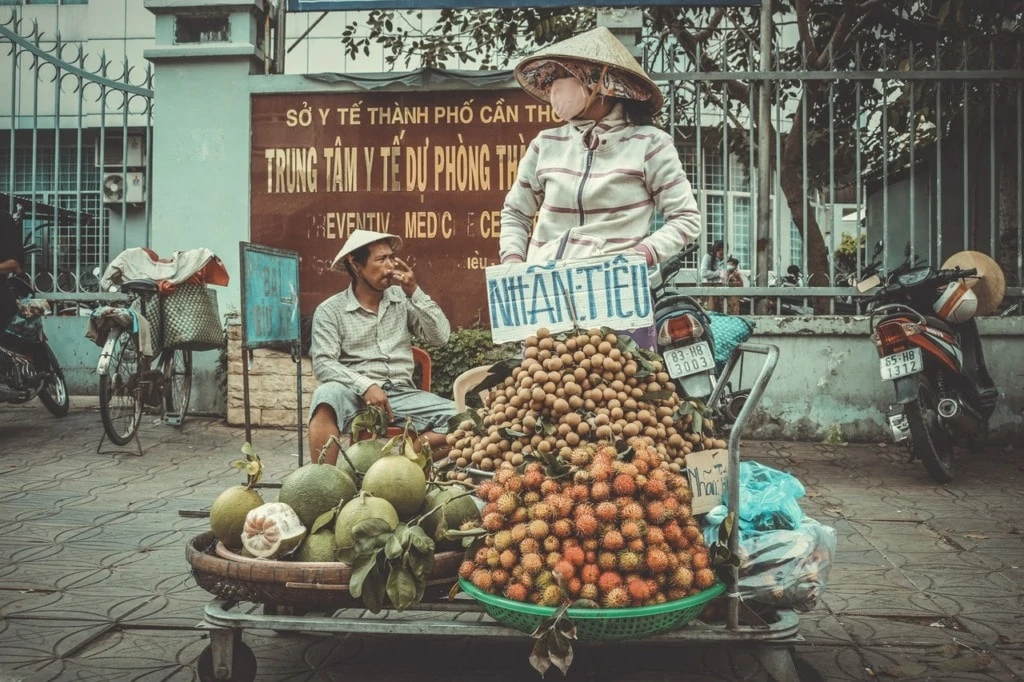
Полезные свойства драконьего фрукта
Драконий фрукт не содержит холестерина и транс-жиров, которые окружают нас повсюду. В его составе присутствуют простые углеводы, поэтому он легко переваривается и усваивается организмом. Содержащиеся в питайе вещества стимулируют работу иммунной системы, ускоряют заживление ран, снижают риск сердечно-сосудистых заболеваний.
Полезные свойства питахайи:
- Драконий фрукт стимулирует иммунитет за счет антиоксидантов, блокирующих свободные радикалы. Витамины и микроэлементы оказывают общеукрепляющее влияние. Питахайя помогает при частых простудных заболеваниях, хронической астме и кашле.
- Нормализует работу пищеварительной системы за счет большого количества клетчатки и косточек, которые усиливают перистальтику кишечника, что ведет к мягкому слабительному эффекту. Усиливает синтез естественных пробиотиков.
- Улучшается внешний кожи за счет витаминов группы В, которые стимулируют обменные процессы в ней, способствуют увлажнению кожи, уменьшают раздражение и оказывают противоспалительное действие.
- Снижает уровень глюкозы при сахарном диабете второго типа. Антиоксиданты и флавоноиды препятствуют образованию опухолевых клеток в толстом кишечнике за счет связывания свободных радикалов и хелирования металлов.
- Питайя обладает противосклеротическим, противовоспалительным, противоопухолевым, противовирусным эффектами. Кальций, содержащийся во фрукте, нужен для остеосинтеза, то есть для строительства костной ткани. Поэтому питахайя обладает еще и антиостеопоротическим эффектами, что особенно значимо для пожилых людей.
- Положительно влияет на сердечно-сосудистую систему, снижая уровень холестерина в крови и нормализуя повышенное давление. Холестерин снижается за счет клетчатки, связывающей избыток желчных кислот и угнетения синтеза холестерина в печени.
- Железо принимает участие в синтезе эритроцитов, кальций укрепляет зубную эмаль и кости.
Джекфрут, или индийское хлебное дерево (нонгка или ка-нун)
Продолговатые шипастые плоды могут достигать веса более 30 кг, но на рынках обычно продают не такие крупные джекфруты. Большие плоды очищают еще до продажи и продают дольками, похожими на огромные зерна кукурузы.
Мякоть нонгка напоминает очень сладкую дыню. Крупные косточки тоже едят, только не сырыми, а отваренными или запеченными – их вкус напоминает жареные каштаны.
Сезон: январь-май.Полезные свойства: очень питателен из-за высокого содержания углеводов, в частности крахмала. Содержит большое количество витамина А и фолиевую кислоту.Как выбрать: спелый плод имеет желто-зеленую или коричневато-желтую окраску, при постукивании издает гулкий звук
Хорошо хранится в холодильнике.Обратите внимание: кожура джекфрута содержит липкий латекс, поэтому, если вы собираетесь чистить фрукт самостоятельно, наденьте резиновые перчатки или смажьте руки маслом. Джекфрут может иметь неприятный запах, как и дуриан.
Start your fruit tour in Vietnam!
The country’s fertile plains and hot tropical climates, as well as the more temperate on the north, all means that almost anything grows here well. As a result, few places in the world claim to have such a rich supply of delicious fruit. If you come to Vietnam during the harvest, that is June to September, you will find a lot exotic fruit greeting you on almost every corner in Vietnam! Take advantage of this abundance by creating your tailor-made Vietnam tour with us! You will choose your interests your own for your tour while group tour will only take you to follow the same pattern. See our most popular tours below. All these can be customized on your requests.
